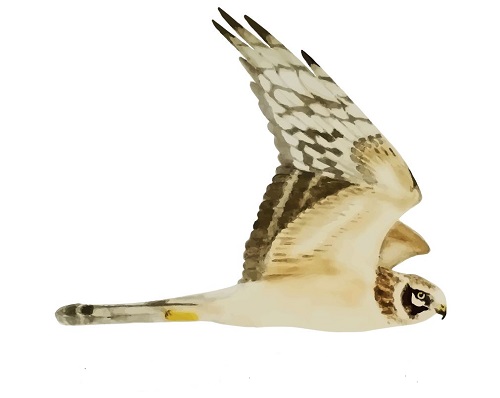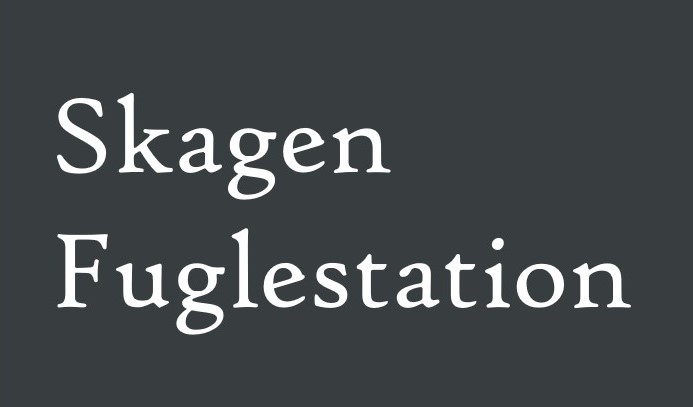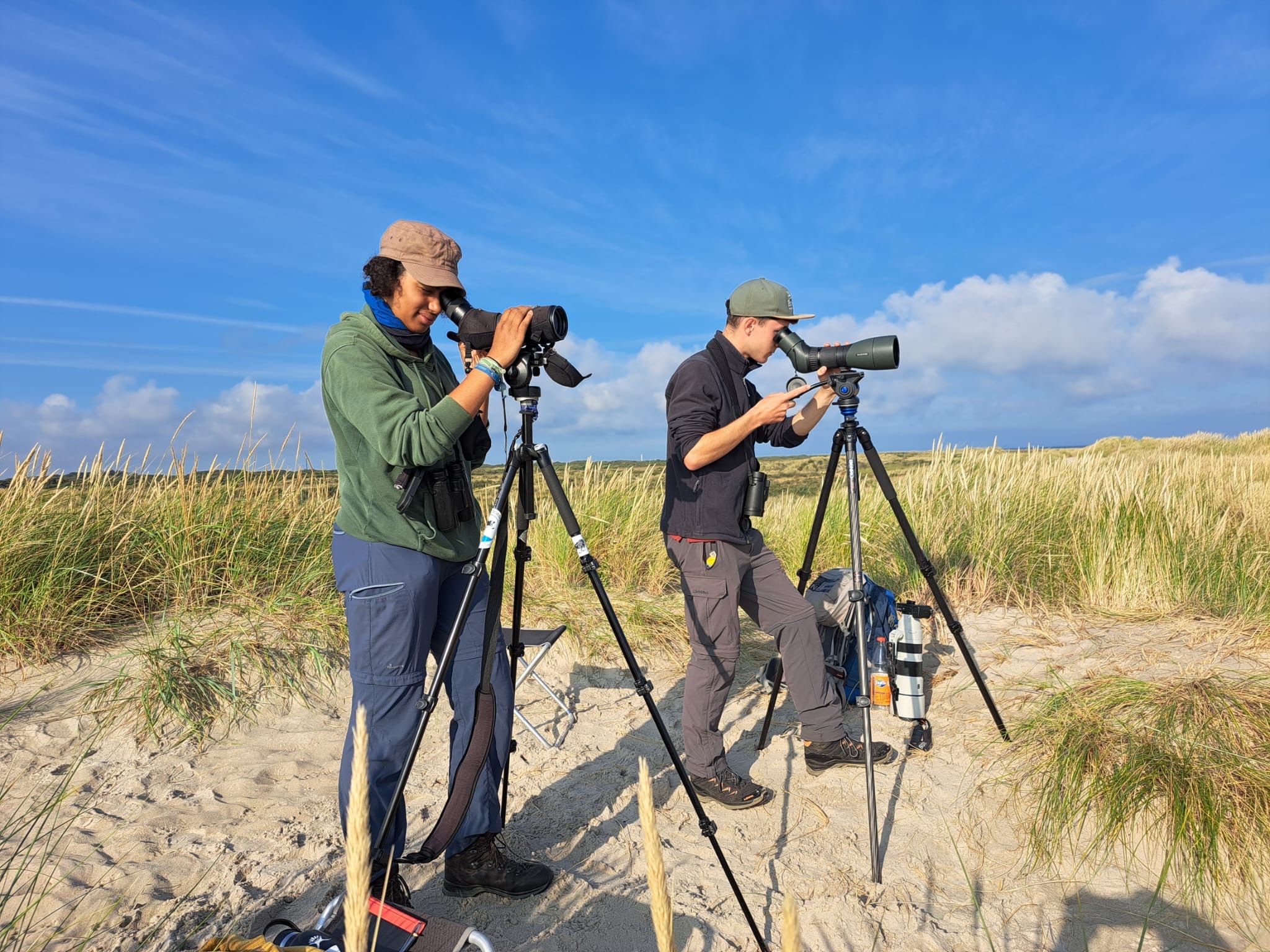Her på Skagen Fuglestations blog bringes korte nyheder i dagbogsformat om hændelser på fuglestationen.
Family trip
Today the waves were blown up high by the winds and the birds had obviously struggle to resist the gusts. Because of the strong winds there was no ringing today. Therefore, we were all out together at obs what was pretty nice. We seeked for some windshelter in the dunes and started our count around sunrise. When the sun came up the sky appeared in many different shades of pink, light blue and orange.
For Gabriel today was the first migration count at Skagen- the other days he had been at the ringing. But he did lots of migration counts in Sweden so that was no problems. For Oscar it was his first day at the station and he started with a good migration day. Besides Common Scoters (Sortand), the ducks appeared in high numbers. Especially the Velvet Scoters (Flojlsand) were, compared to the Common Sortand, highly abundant. Sarah, who counted the Flojlsand, was very pleased about that. Most birds appeared in good light and we were happy to see a flock of Pintails (Spidsand) with one Wigeon (Pibeand) directly above our heads.
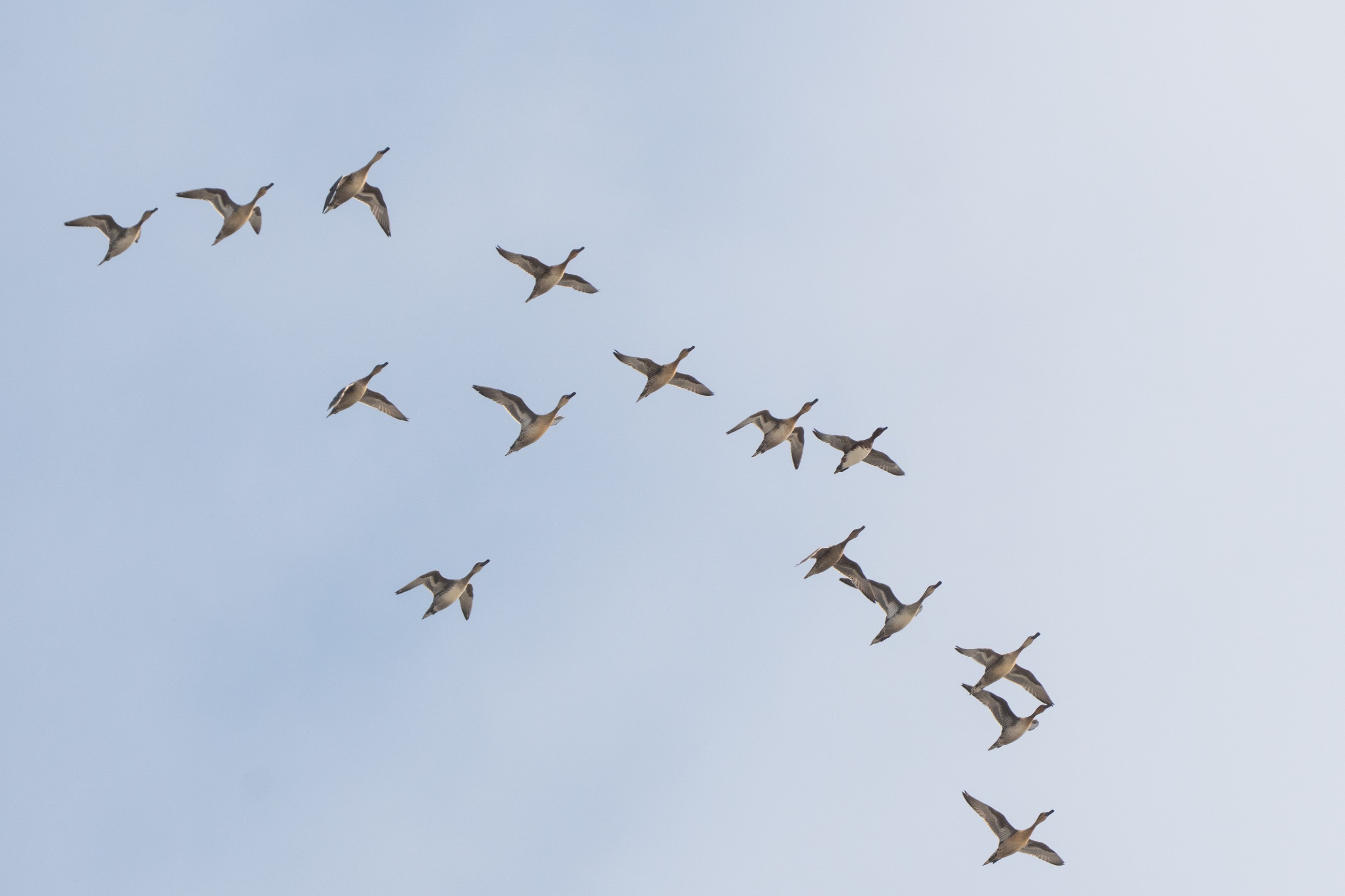 A flock of Spidsand with one Pibeand inbetween
A flock of Spidsand with one Pibeand inbetween
After some time, four Divers were coming in. One of them was a Black-Throated-Diver (Sortstrubet Lom) and we could compare it very well with the three Red-Throated-Divers (Rødstrubet Lom) flying close. We also saw some nice waders as Ruff (Brushane) or Grey Plover (Strandhjejle).
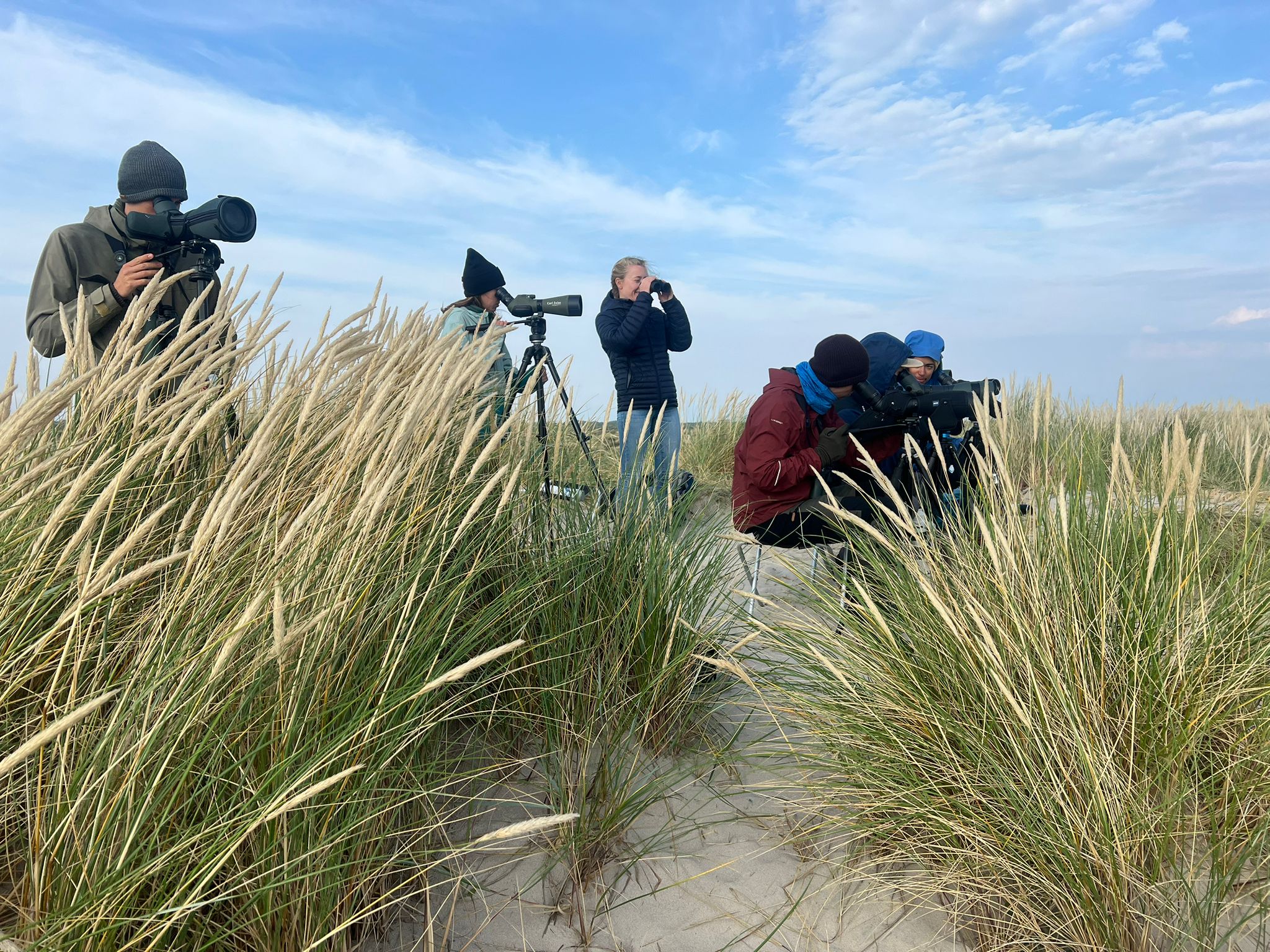 All together at morning obs
All together at morning obs
When the count was finished, we headed out to check Ellekrattet for some passerines. We could not see that much, but on our way back through the heath we were surprised by a Cuckoo (Gøg). Furthermore, there were some Wheatears (Stenpikker) resting and I am always very happy, when I see some. I looked out for a Mursejler, but unfortunately no one showed up. So maybe we have already seen our last ones for this season.
After a small break at the lighthouse, we went into town to eat some Danish cake at the bakery. That was very delicious. We sat in the garden, enjoyed the warm sunbeams and played some card games. As a big fan of card games, I really enjoyed that. After heading over to Selinas location and playing some more rounds, it was time to go back to the station. There Sarah, Flo and I jumped into the ocean. The waves were still high and we had a good time in the surge. After a productive afternoon with typing in data, it was time for some nice dinner.
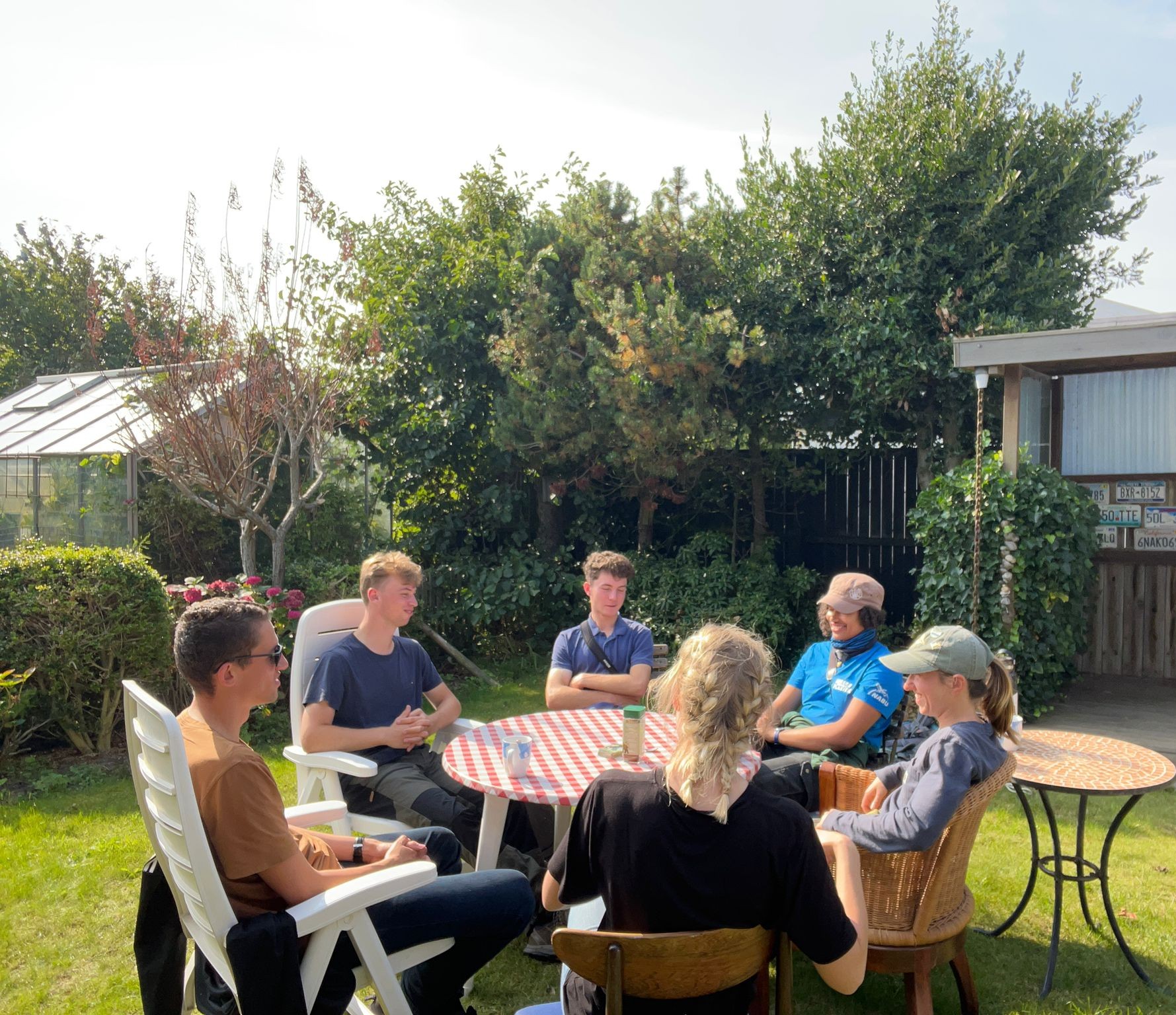 Relaxing with card games and coffee
Relaxing with card games and coffee
No ringing today
Highlight from todays observation
Spidsand 14
Sortstrubet Lom 3
Gøg 1
Many migrating Lomvie compared to the last days
People: Gabriel Axelsson, Florian Hatt, Selina Veng, Janna Ouedraogo, Sarah Partridge, Óscar Pachá Guerras
Today’s observations in Dofbasen from observers in the area.
Ends and Beginnings
Today, we sadly had to say farewell to Barbara who is going back to the Faroe Islands after a stay at Skagen Fuglestation that felt way too short. We very much enjoyed observing and ringing with her, and hearing about birding on the Faroe Islands (in an Australian accent!).
But with endings come new beginnings, and we are now very excited to welcome Oscar to the station!
At ringing at Kabeltromlen, Gabriel, Sarah, Barbara and I were again joined by Morten, who was part of the team that opened Skagen Fuglestation back in 2017. It was a pleasure to ring with him and fun to hear some stories from the old days of the station.
The highligts in the ringing included another Common Snipe (Dobbeltbekkasin) and no less than 18 Blackcaps (Munk).
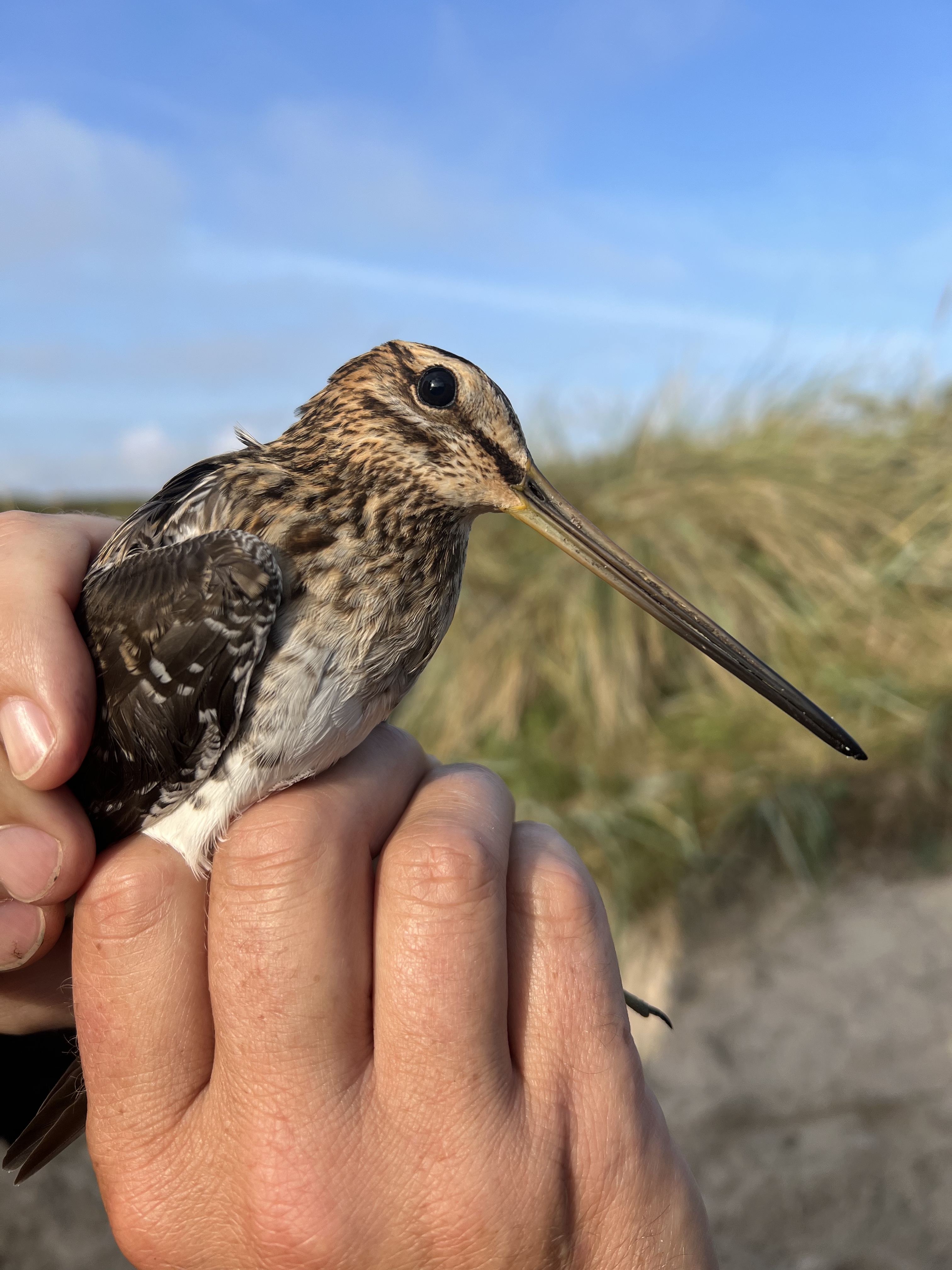
Dobbeltbekkasin
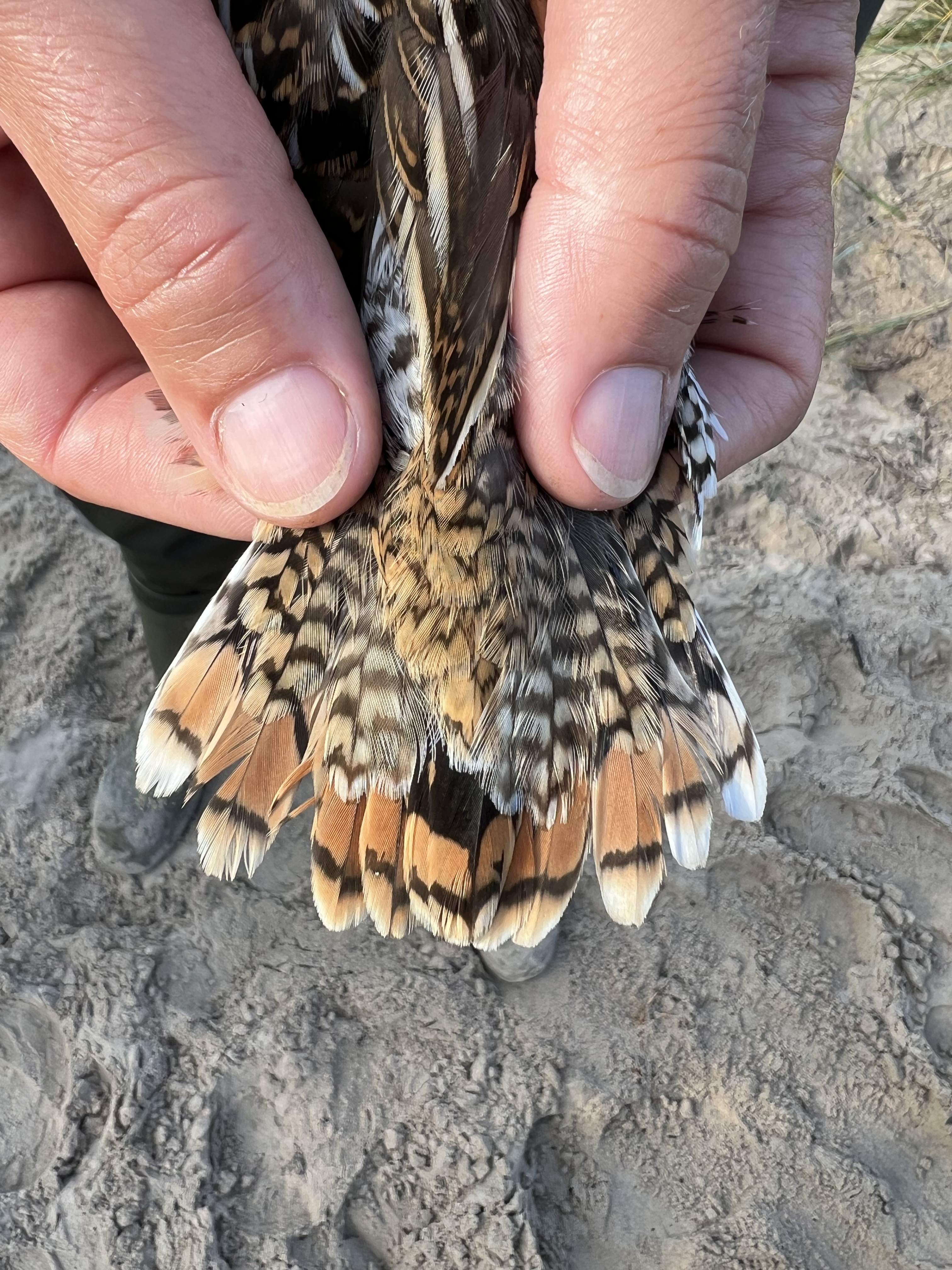
Look at that beautiful tail (Dobbeltbekkasin)
Janna and Florian had a good morning doing migration count at Worlds End 3 with Arctic Skua (Almindelig Kjove) in dark morph, female-coloured Hen Harrier (Blå Kærhøg), Merlin (Dværgfalk), Black-throated Diver (Sortstrubet Lom) and Black guillemot (Tejst). An interesting sight was a Cuckoo (Gøg) that flew with the gulls and headed out for the sea, but then changed its mind in the last second and went back inland.
The observers stayed out an extra hour to see if they could spot other cool species and actually heard a Wood Sandpiper (Tinksmed)!
Janna and Florian scanning the waves at World’s End 3
Back at the station Janna prepared a lovely lunch for us, and just as we finished eating, we heard the message on Zello: There is a Hoopoe (Hærfugl) in town, not far from us! Gabriel and Florian went out to look for it with some of the locals, but unfortunately it wasn’t spotted again. Fingers crossed it heads our way tomorrow.
Tomorrow looks too windy for ringing, so we’re looking forward to spending the morning doing migration counts together.
Ciao!
Ringing totals Kabeltromlen
Munk: 18
Rødhals: 7
Gransanger: 7
Sortmejse: 4
Gærdesanger: 3
Rødstjert: 3
Jernspurv: 2
Dobbeltbekkasin: 1
Rørspurv: 1
Tornsanger: 1
Blåmejse: 1
Kærsanger: 1
Løvsanger: 1
Total: 50
Highlights from World’s End 3:
Almindelig Kjove
Blå Kærhøg
Dværgfalk
Sortstrubet Lom
Tejst
Gøg
Obervations from the area can be found here.
People: Oscar, Barbara Leone, Gabriel Axelsson, Florian Hatt, Selina Veng, Janna Ouedraogo, Sarah Partridge, Morten Jenrich Hansen.
Over a thousand Scoters
 Great Spotted Woodpecker (Stor Flagspætte) captured today
Great Spotted Woodpecker (Stor Flagspætte) captured today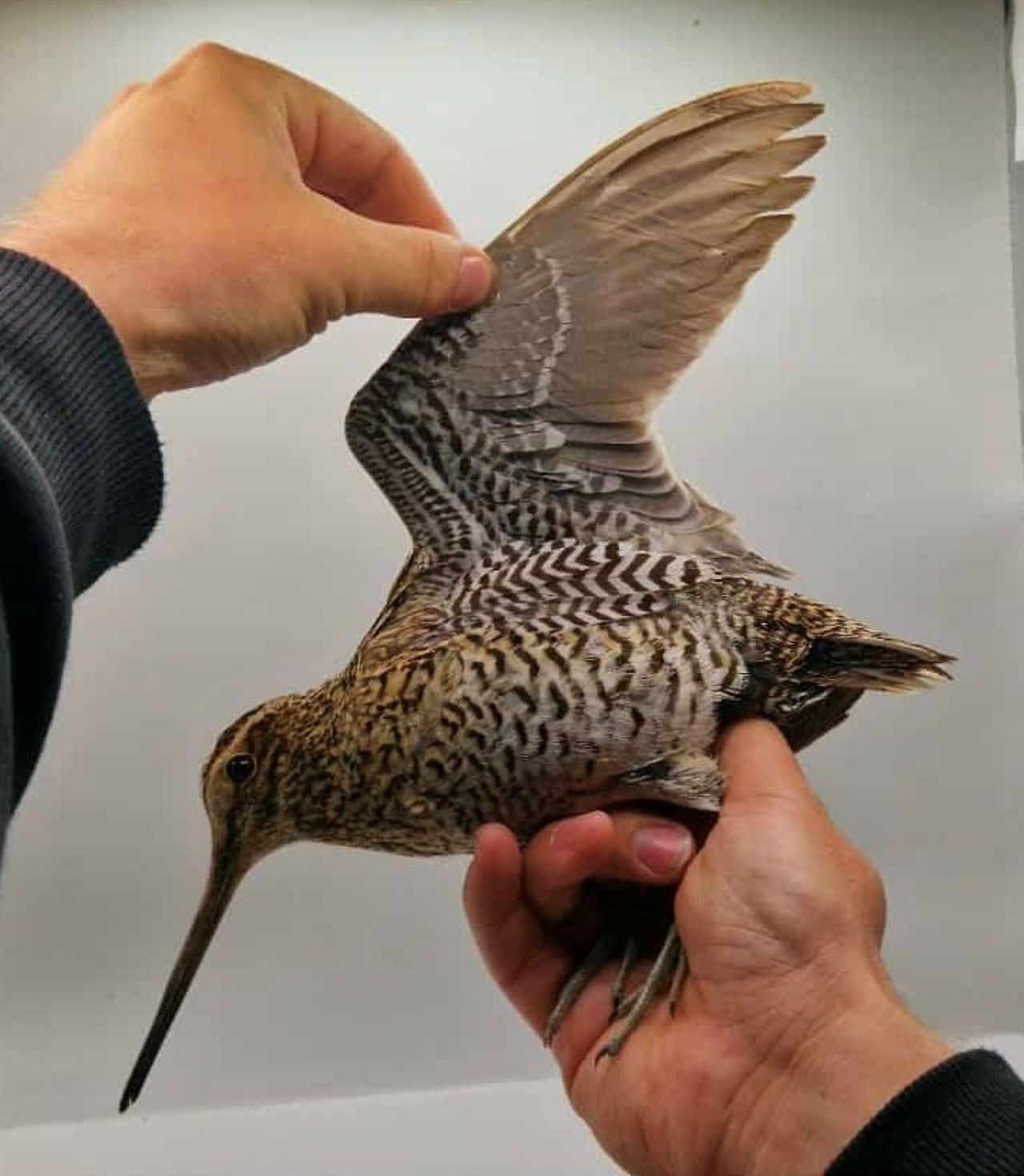 Adult Great Snipe (Tredækker)
Adult Great Snipe (Tredækker)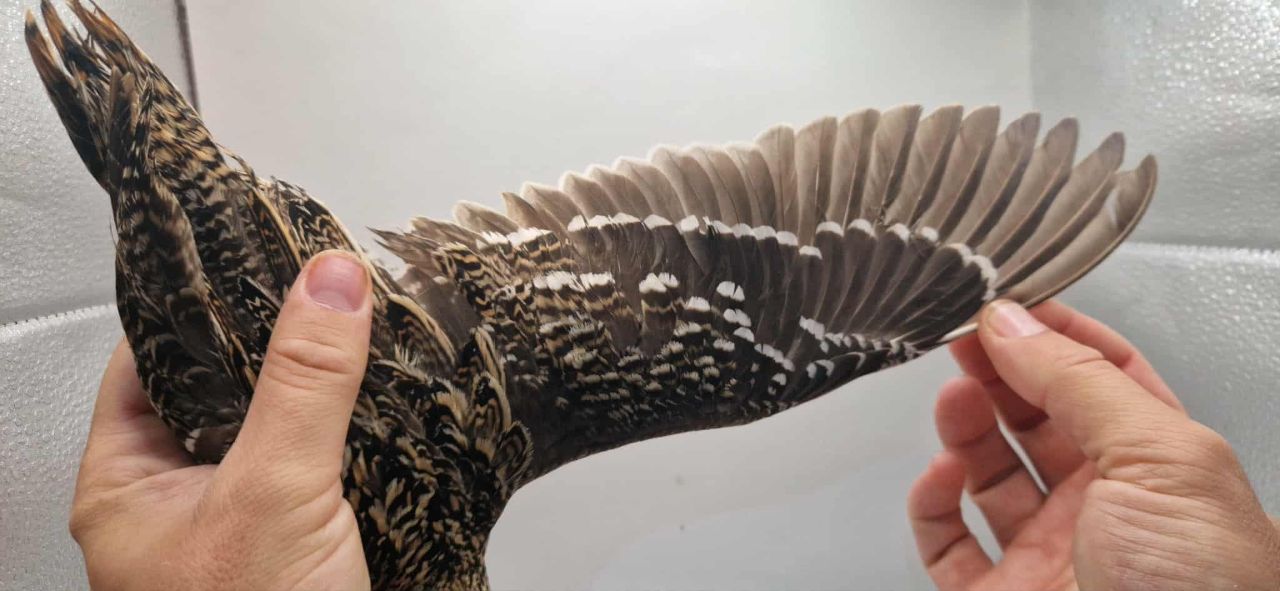 Broard white wing bars on median coverts are among the characters for adult Great Snipes (Tredækker)
Broard white wing bars on median coverts are among the characters for adult Great Snipes (Tredækker)
Munk 13
Stor Flagspætte 1
Musvit 1
Rødhals 3
Jernspurv 1
Sortmejse 8
Gærdesanger 3
Blåmejse 1
Bogfinke 1
Rørspurv 1
Træløber 1
Total 35
Highlights from World’s End 3:
Fiskeørn
Sølvhejre
Dværgfalk
Obervations from the area can be found here.
People:
Barbara Leone, Gabriel Axelsson, Florian Hatt, Selina Veng, Janna Ouedraogo, Sarah Partridge, Morten Jenrich Hansen.
Three twitches in one day
After helping to set up the storm petrel nets in the evening before today, I went to bed, hoping to be woken as often as possible from the others to see some exciting birds they caught. After a few hours Sarah came into the room and shouted: „Wake up, we caught a Nightjar!“ We immediately got up and went down to the Lab where this fascinating bird was waiting for us. I'd never held a bird in my hands before, so this Nightjar (Natravn) was the first one for me! When we let him go again, he said goodbye by first flying into Selina's face but then disappearing behind the lighthouse.
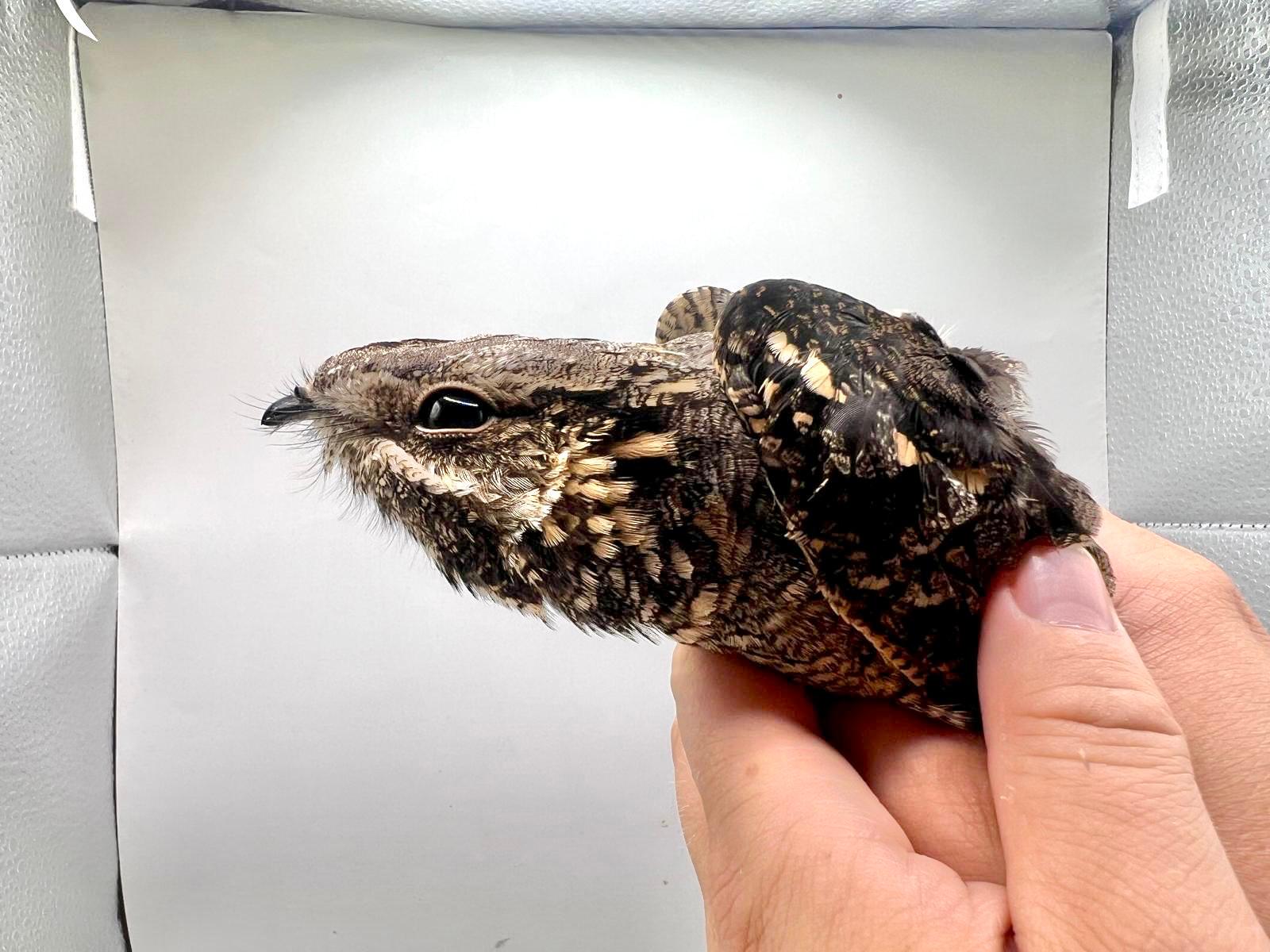
The beautiful nightjar (natravn) for which we all got up to see.
In the morning I went out with Sarah to Worlds End III for another morning of migration count. Knud was back today and was a great help with the count. The migration was rather slow, so Knud also kept an eye out for Caspian gulls (Kaspisk Måge). After two hours, he went down to the beach to read some of the gulls' rings. Then Barbara came to relieve Sarah, who went to her well-deserved sleep. The migration picked up speed again, a dark morph Arctic/Long-tailed skua (Almindelige/Lille Kjove) moved to northwest and a Merlin (Dværgfalk) flew in from the sea at high speed. To round things off, a small raptor, most likely Marsh harrier (Rørhøg) came in from the sea.
In the meantime, Lisa, Janna, Gabriel and Selina had ringed some nice birds, for example a Common Snipe (Dobbeltbekkasin), a Great spotted woodpecker (Stor Flagspætte) and many Blackcaps (Munk). Barbara and I also came along for the last round so that I could gain some more experience with handling birds.
After a quick lunch, Barbara, Selina, Gabriel and I got in the car to see the reported pair of Black-Winged Kites (Blå Gente) in Midtjylland. I took a short nap in the car and also used the journey to write this blog. It's my first one, by the way, and I'm also the first volunteer from Switzerland at the Skagen Fuglestation and really looking forward to stay here for the next three months until the end of the season. But back to the Black-winged Kites. We got some distant but still very nice views of the pair that was carrying nesting material from time to time. In my opinion it‘s one of the most beautiful raptors existing out there!
In the meantime Janna tried to do our second twitch of the day. A Red-breasted Flycatcher (Lille Fluesnapper) had been called out on Zello. But unfortunately the bird didn't show up again.
In the evening we went up the lighthouse to make our third twitch today. After some minutes waiting, we saw what we had hoped to see: the blood moon! What a nice way to end this day!
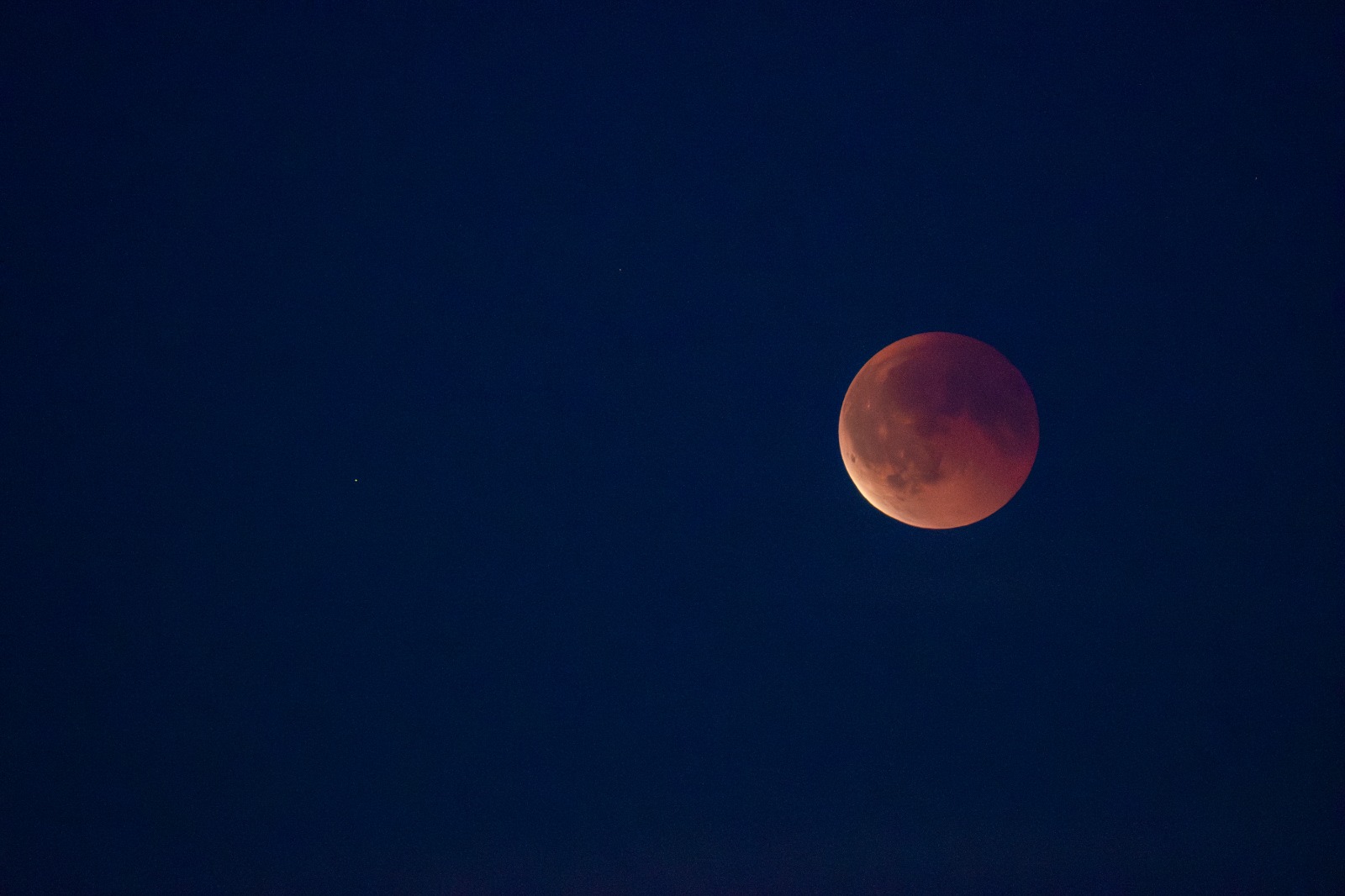
Nice blood moon seen from the lighthouse
Ringing totals:
Ringing KAB
Dobbeltbekkasin 1
Stor flagspætte 1
Musvit 1
Rødstjert 4
Sivsanger 1
Rødhals 10
Gærdesanger 1
Gærdesmutte 1
Jernspurv 1
Broget fluesnapper 2
Rørsanger 1
Sortmejse 3
Munk 17
Tornsanger 1
Blåmejse 1
Gransanger 2
Fuglekonge 2
Træløber 1
Total 51
Ringing Fyr
Natravn 1
Highlights from World's End III
Arctic/Long-tailed Skua (Almindelig/Lille Kjove)
Merlin (Dværgfalk)
Caspian gulls (Kaspisk Måge)
Red-breasted Merganser (Toppet Skallesluger)
Obervations from the area can be found here.
People:
Barbara Leone, Gabriel Axelsson, Florian Hatt, Selina Veng, Janna Ouedraogo, Sarah Partridge, Simon S. Christiansen, Lisa Vergin, Knud Pedersen.
Birds, Bats and Buddies
I joined the ringing team this morning and got my first proper lesson in the artful skill of ringing a bird. The day started at 5am, riding our bikes down to Kabeltromlen and putting up the nets. Walking the so-called “rounds” from net to net to check for birds, wearing waders as the sun was rising, was a really lovely way to start the day and get to know the people on the team. One of the ringers morning-routines is also to call out a number of how many birds will be caught on the day and todays guesses varied from high 40’s to 60. The skilled and patient supervisor Lisa showed me how to get birds out of the nets, how to handle the delicate and tiny little birds, and how to ring, sex and age them while making it look easy, which is it not! The sun rose and the nets got busy. Coal Tits (Sortmejse) were the main act with 21 captures, but the best finds were a Tree Pipit (Skovpiber) and a Common Redpoll (Stor Gråsisken) and also known as Mealy Redpoll and both were new species for me. The day ended with exactly 50 birds, which meant that Selina won the daily comp! Congratulations.
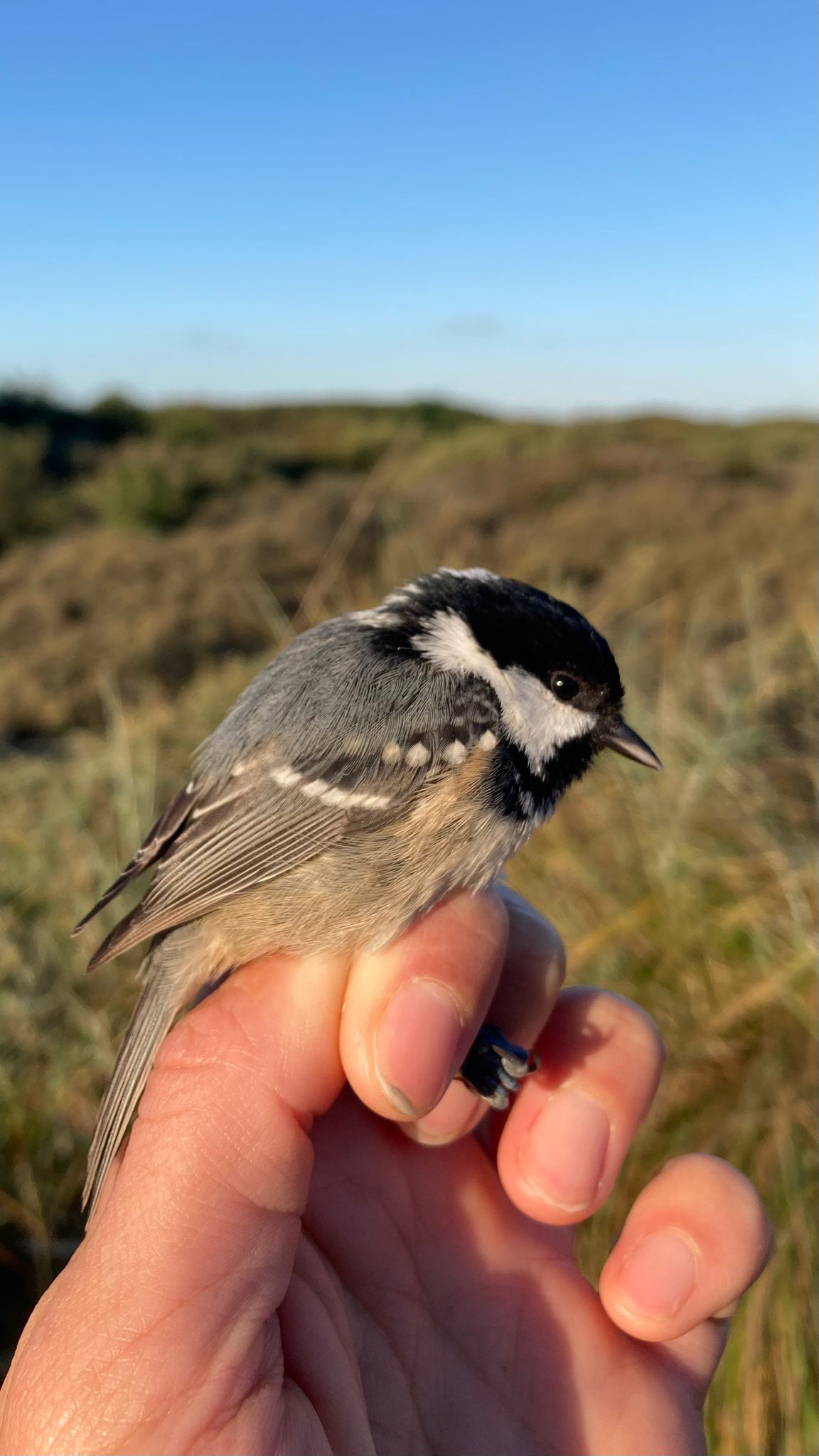
One of the many captured Coal Tits (Sortmejse) from today.
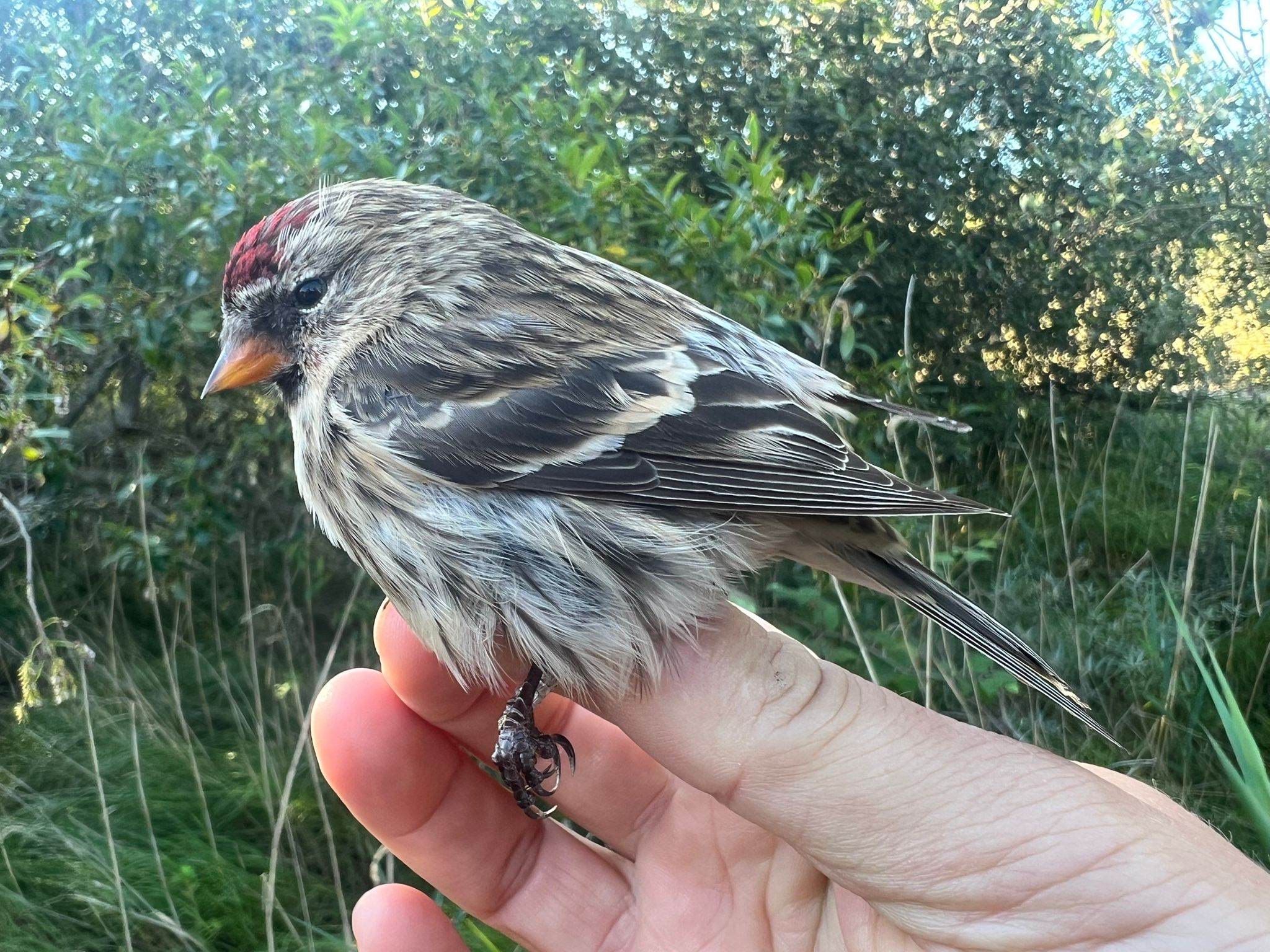
Photo of the Common Redpoll (Stor Gråsisken) from today
While some of us were out ringing, the observers also had a pretty eventful morning at Worlds End III (Grenen). They saw Arctic Skua (Almindelig Kjove), Bar-tailed Godwits (Lille Kobbersneppe) and a Red-necked Grebe (Gråstrubet Lappedykker), but the biggest suprise came in the shape of yet another bat who flew in and landed on the dunes during the counting session. Florian was able to take pictures on the tracks of the bats, which pretty clearly show how it was crawling along the sand, which is pretty cool.
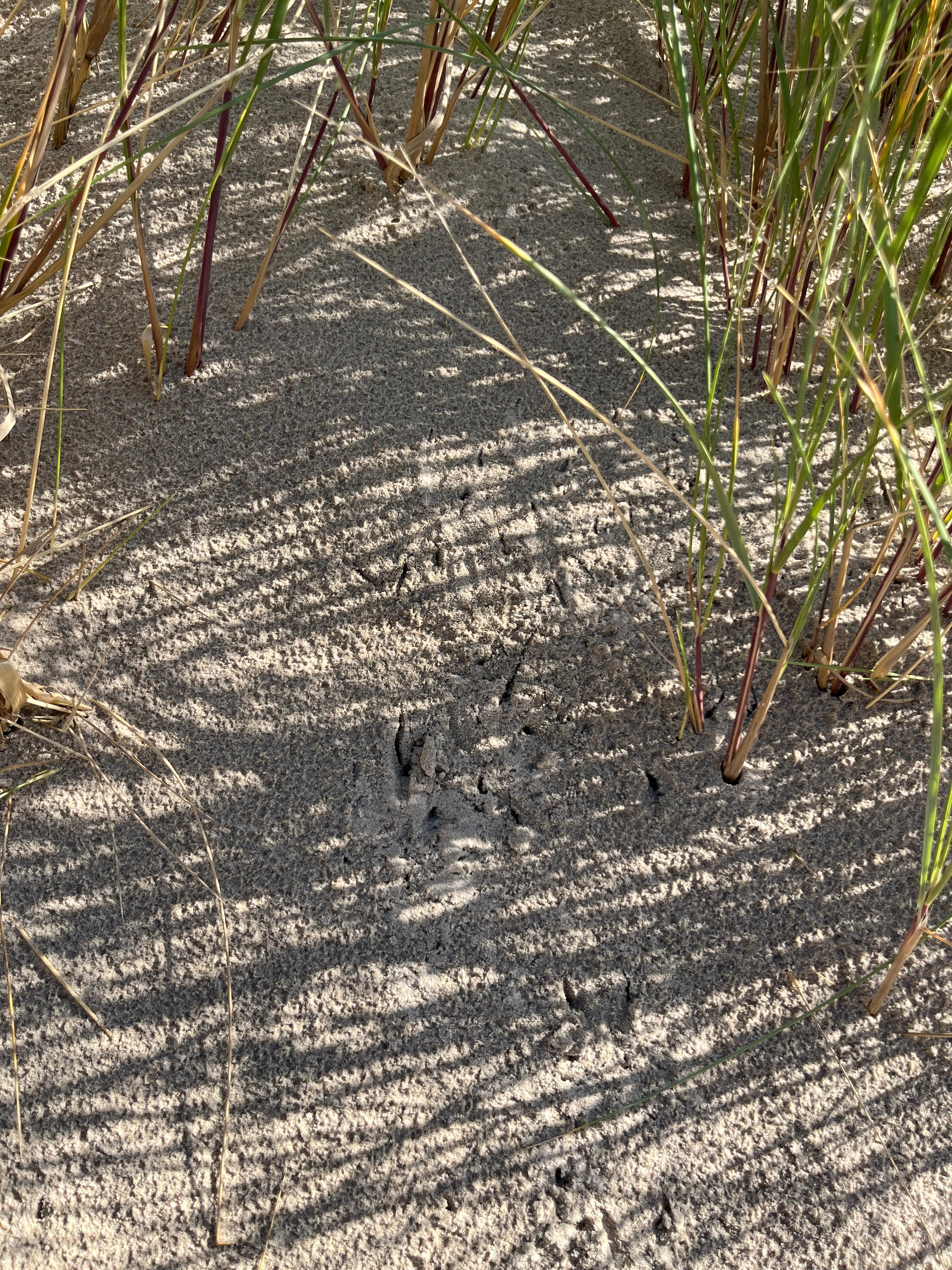
Tracks from the crawling bat. You can clearly see the marks that it's spur-like thumbs have left in the sand.
This afternoon was spent cleaning back at Det Grå Fyr and with everyone helping, the place is now looking clean and (mostly) sand-free again.
Tonight marks a special night for the team (especially for our Storm Petrel lover, Sarah) as today is the last day that we will be trying to catch Storm Petrels (Stormsvaler) in the beach nets. The plan is to finish with a bang and leave the nets open until sunrise – let’s see if we get lucky.
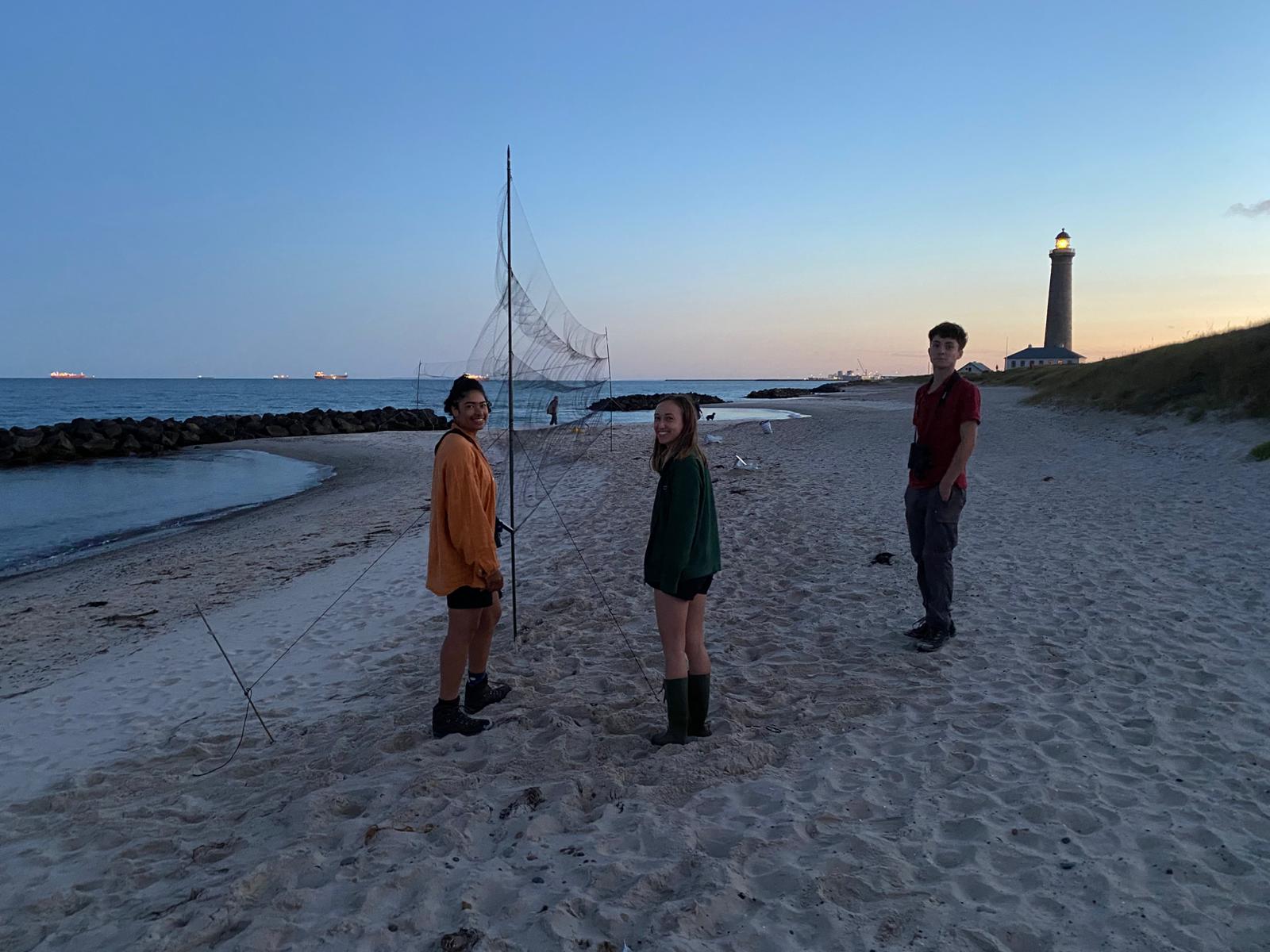
The hopeful team putting up the last Storm Petrel net of the season.
Ringing totals:
Rødstjert 2
Løvsanger 1
Rødhals 2
Sortmejse 21
Jernspurv 1
Lille gråsisken 5
Stor gråsisken 1
Sivsanger 1
Rørsanger 1
Munk 7
Rørspurv 3
Skovpiber 1
Havesanger 1
Tornsanger 1
Blåmejse 1
Gransanger 1
Total 50
Highlights from World's End III
Arctic Skua (Almindelig Kjove)
Barre-tailed Godwits (Lille Kobbersneppe)
Red-necked Grebe (Gråstrubet Lappedykker)
Obervations from the area can be found here.
People:
Barbara Leone, Gabriel Axelsson, Florian Hatt, Selina Veng, Janna Ouedraogo, Sarah Partridge, Simon S. Christiansen og Lisa.
Batman is actually afraid of bats
Last night we put up the Stormsvale and Natravn nets, in the hopes of catching some late Lille stormsvale or Stor stormsvale. We put Florian and Gabriel to work straight away putting up the nets on the beach, and then I took the first half of the night shift. This was mostly uneventful, until I went to do one last round around 1.30 and saw there was not a Natravn but a Myotis bat trapped in the net. This was my first bat extraction and I was glad that Jeppe was there to provide some company for the extraction, which was a bit long since I was wearing gardening gloves to avoid its rabid jaws. The bat was very agitated and loud and extremely cute. Jeppe and I admired it for a minute and then released it and I was sad I forgot to take a picture! But after I went to wake up Janna to take over the rounds, she immediately found another bat in the net, maybe the same poor soul trapped again! She was switched on enough to take a photo. Simon was glad he didn’t have to come over to extract the bat because he is afraid of them, yet another suspicious similarity with Batman.
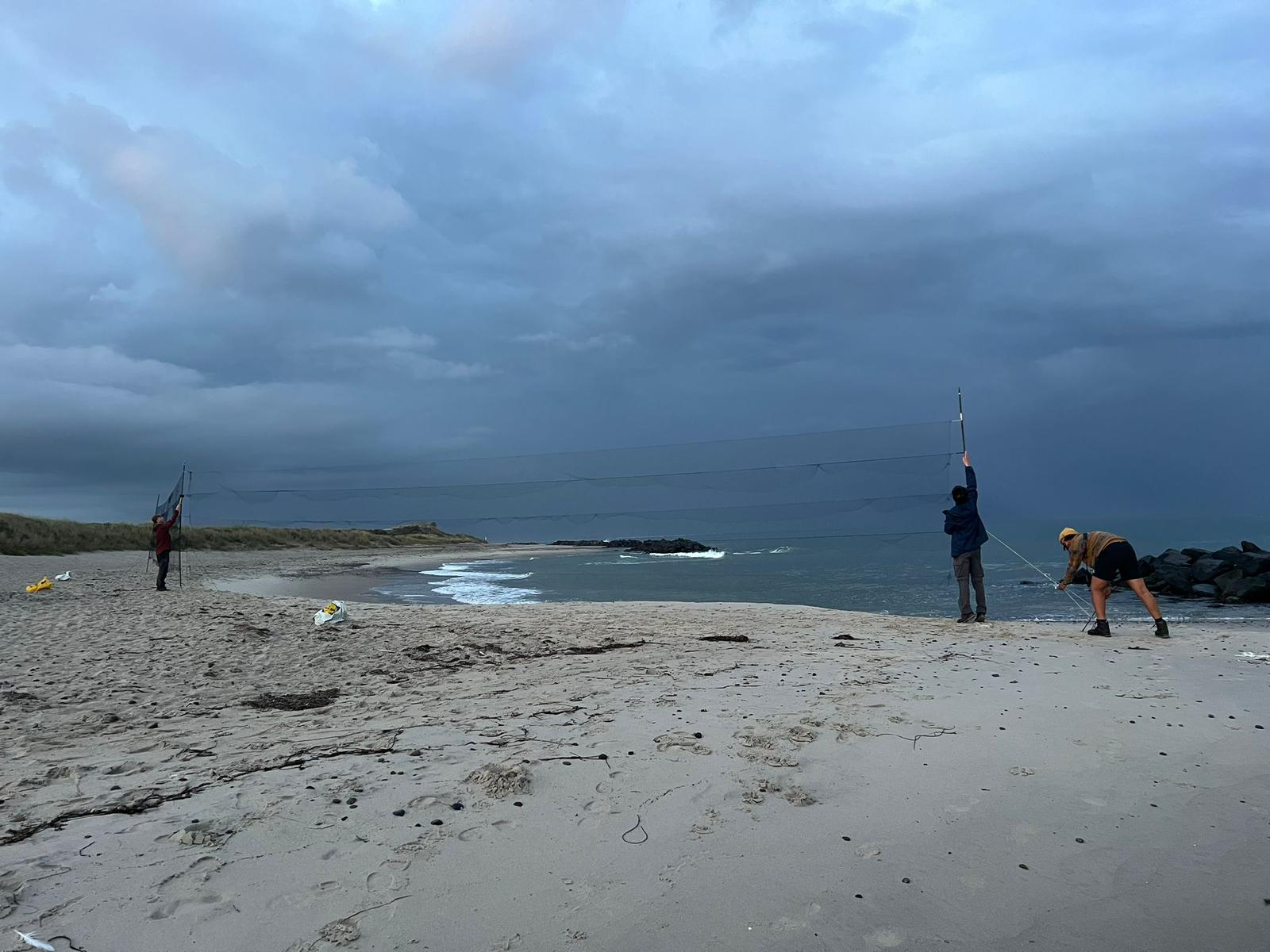
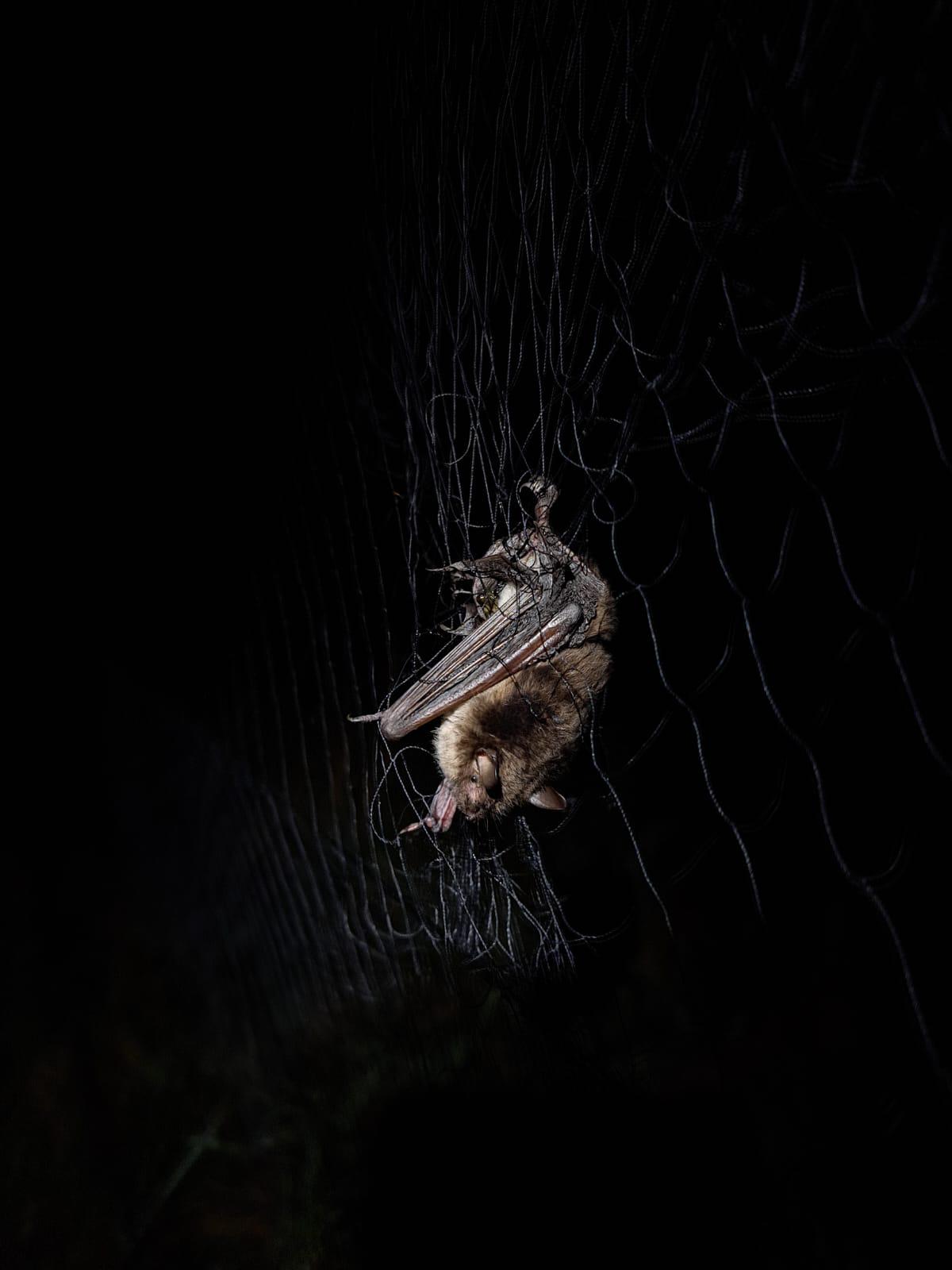
In the morning I went with Barbara and Florian to go observing at World’s End III. It was a fantastic morning and Florian is superhumanly observant and very fun to seawatch with. Within about 30 seconds of arriving, he spotted an Arctic Loon (Sortstrubet Lom) and before I turned my scope to look at it he also spotted an Artcic skua (Almindelig Kjove), setting us up for an eventful morning. We also saw one bat flying over the sea, bringing the total number of bats I have seen in Skagen to 2. Sadly the observation was cut short by the rain, which reduced visibility a lot so we left after only three hours.
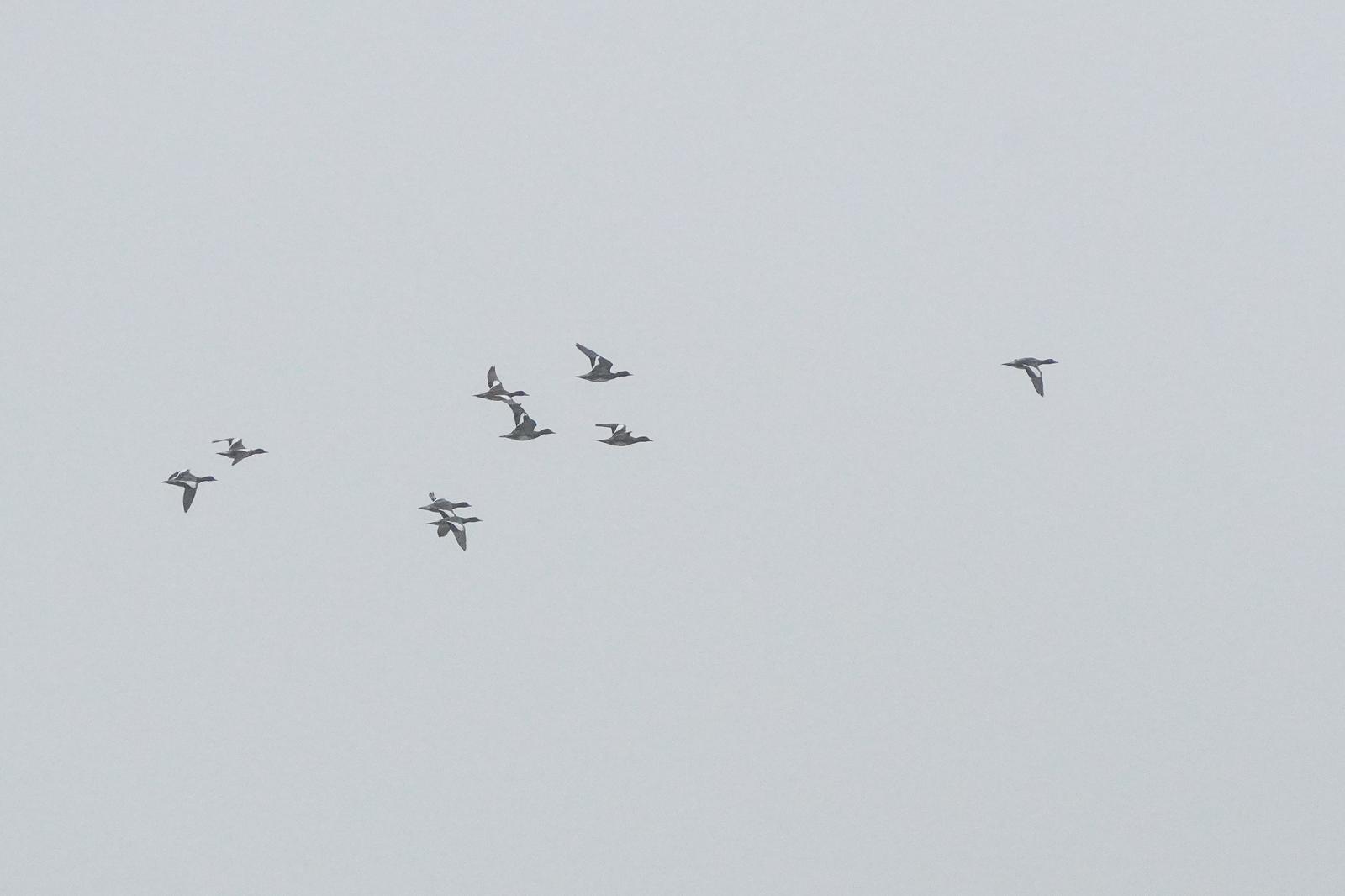
Janna, Selina, and Gabriel went ringing with Simon this morning, which was also very eventful before the rain. They trapped 26 sortmejse today, in the midst of a large sortmejse influx, which is not occurring every year. They also trapped one each of spotted and pied flycatcher (grå and broget fluesnapper), two rødstjerts, and two havesangers, among many others.
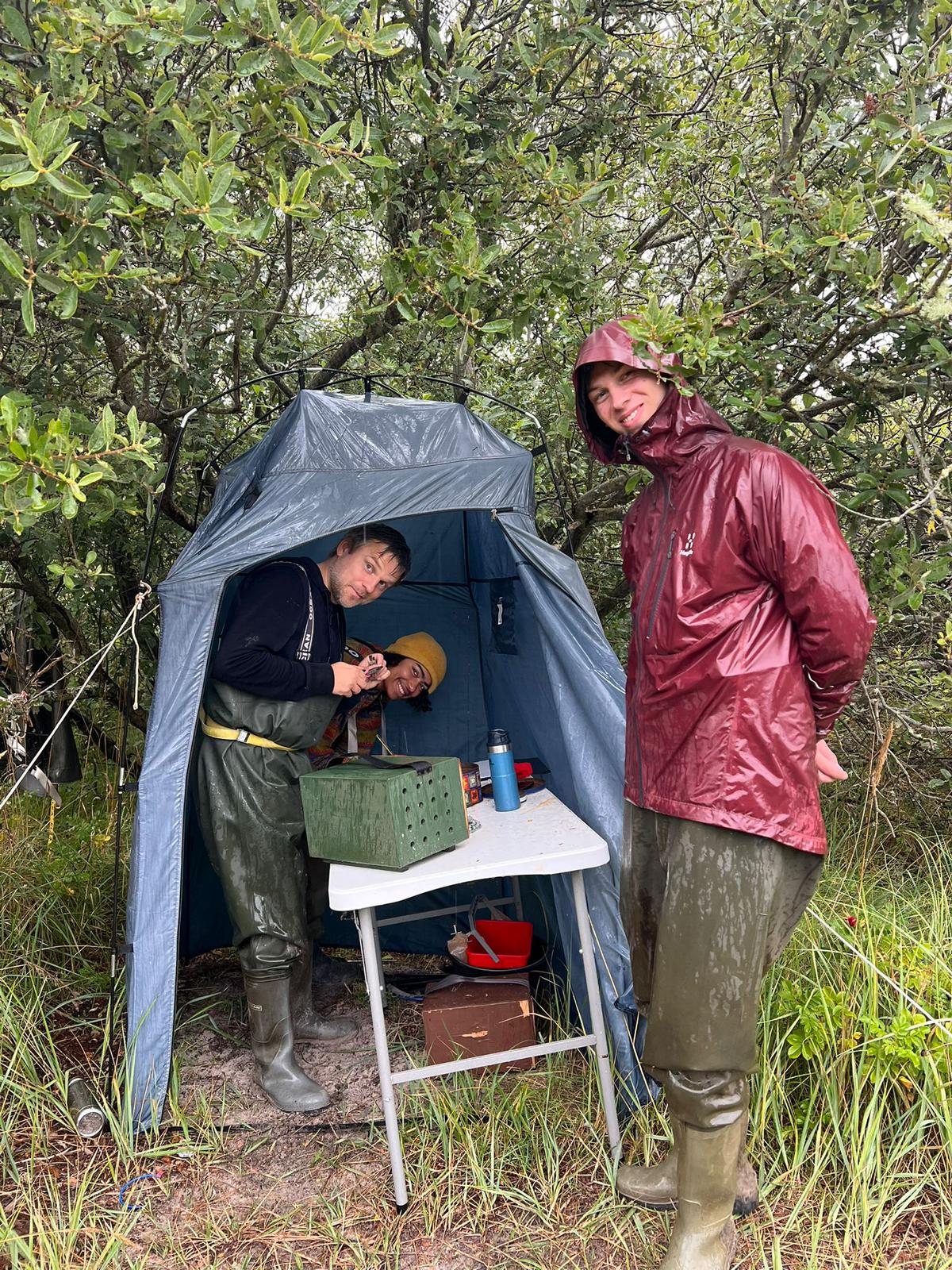
When we came home cold and wet, we smelled some delicious baking and saw that our guest Helle was cooking us a tasty treat of fresh bread! In the afternoon Janna and I went for a cold swim in the rain, and then Helle kindly drove us to the shop. After that I went for a nap, and Gabriel and Janna went birdwatching and saw the first Jack Snipe (enkeltbekkasin). After some data entry and office tasks, the crew are playing cards together and showing off magic tricks, a very cozy atmosphere in the lighthouse.
Ringing totals:
Rødstjert 2
Løvsanger 4
Grå fliesnapper 1
Sortmejse 26
Jernspurv 1
Broget fluesnapper 1
Dompap 1
Havesanger 2
Munk 8
Blåmejse 1
Gransanger 2
Total 49
Highlights from World's End III
Sortstrubet Lom, Almindelig Kjove, Fløjlsand, Dværgmåge, Hjejle, Tejst.
Obervations from the area can be found here.
People:
Barbara Leone, Gabriel Axelsson, Florian Hatt, Selina Veng, Janna Ouedraogo, Sarah Partridge, Simon S. Christiansen, Jeppe and our guests Helle and Johan.
A Windy Morning with a Great Skua
My first blog post and my first time volunteering at Skagen Fuglestation!
It is great to be here and I have already met a lot of awesome people who are teaching me so much: Sarah, Janna, Simon, Simon Jr., and Youri. There is a lovely community, including our guests Helle and Johan, and local birders who often join and help out.
Not an hour goes by without learning something new about birds, moult limits, moths, handling nets, night catching etc. I am also learning that sleep is a smaller part of life here, but who wants to sleep when you can watch birds. I have ringed my first bird ever which was a strong young House Sparrow (Gråspurv)!
Today we woke up to some windy conditions which meant that we had to skip ringing. This gave us an extra hour of sleep before we went to do observations at World’s End 3, in front of a beautiful sunrise. It was my first time doing migration count, and Janna and Sarah were great in introducing me, and luckily we were joined by Knud (thanks for spotting birds and counting the many gulls!) and Ole as well.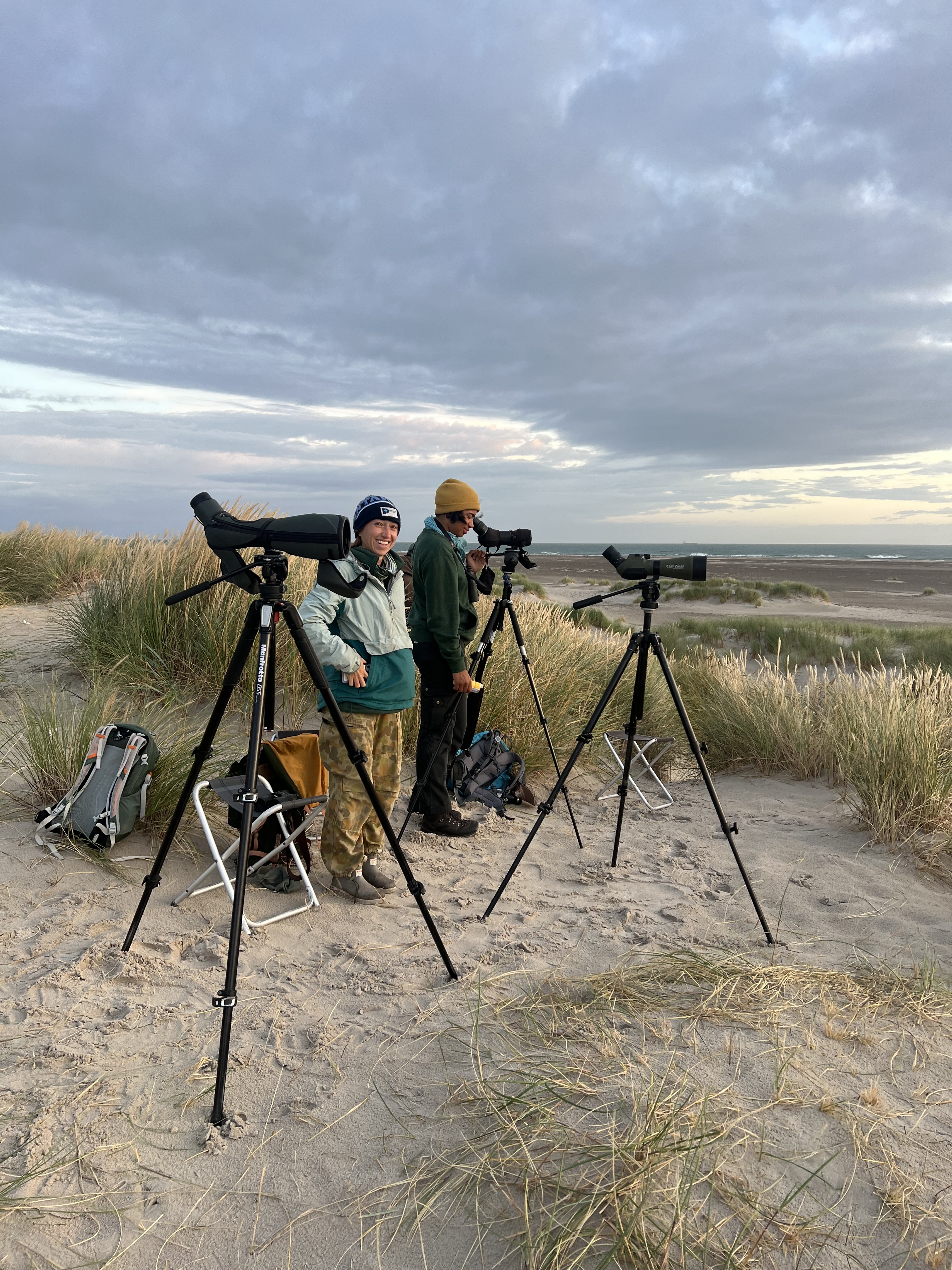
Janna and Sarah counting Northern Gannets (Sule) and Common Scoters (Sortand) in the morning sun
A very exciting bird today was a Great Skua (Storkjove), the first one for me, and I even spotted it myself! Besides that, some honourable mentions from the day are Caspian Gull (Kaspisk Måge), Velvet Scoter (Fløjlsand), Black Guillemot (Tejst), Tufted Duck (Troldand), and Sandormen (the bus that takes people to Grenen) that almost got stuck in the sand. Two migrating Wood Pigeons (Ringdue) flying along the shore were a cute sight. We also enjoyed a couple of Swifts (Mursejler) who still haven’t moved south yet. Whenever we see swifts these days, Janna bids them farewell, wondering if these might be the last of the year. Maybe these two were.
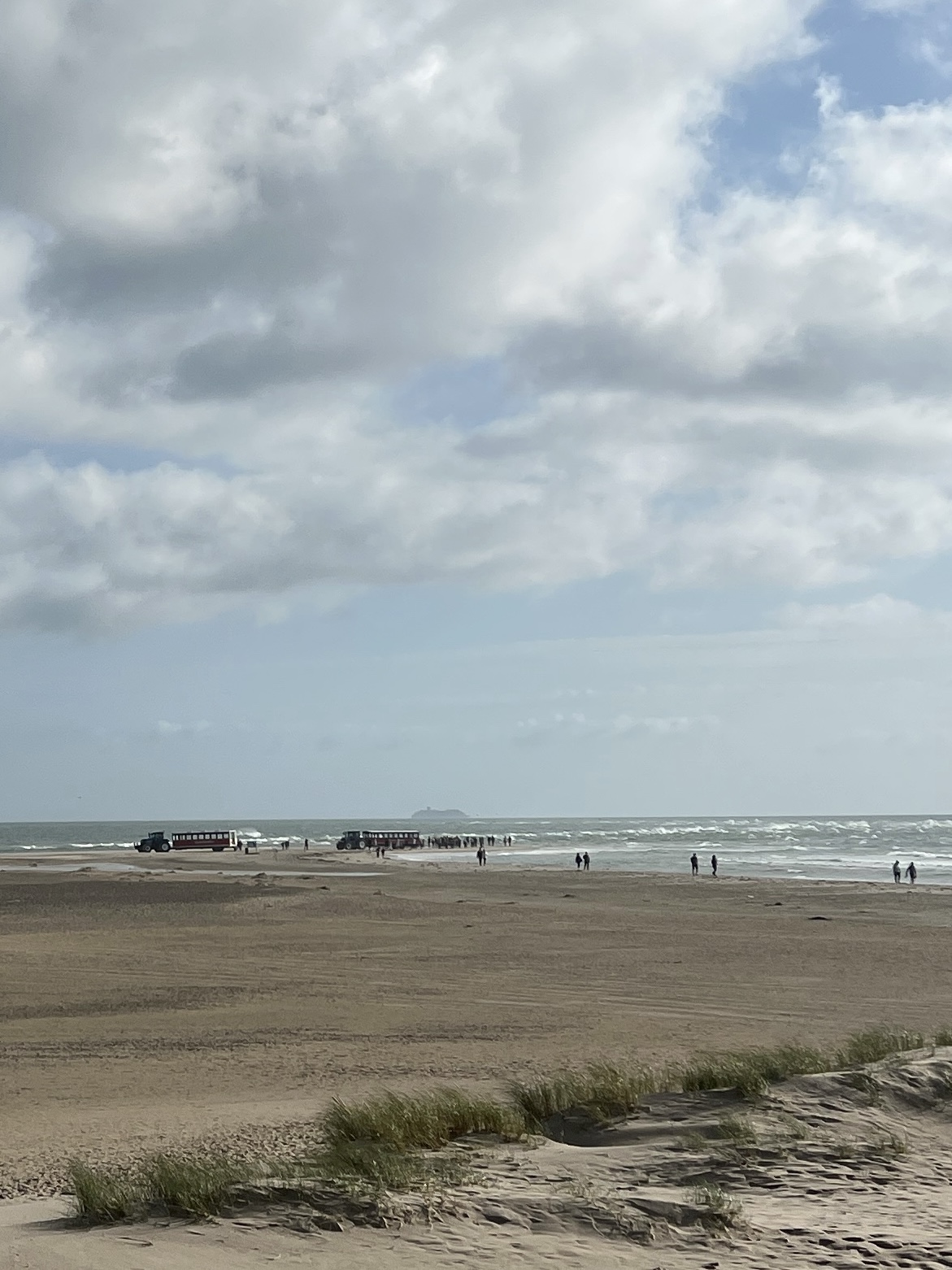
People walking or taking Sandormen to the tip (when Sandormen gets stuck it is definitely faster to walk!)
In the afternoon, Florian and Gabriel moved in, and Barbara will arrive in the evening, so there’s a lot of activity at the station again!
We are going to try to catch Storm Petrels (Stormsvaler) tonight, and hopefully Gabriel, Florian, and Barbara brought some luck with them and we can make up for the empty nets a few nights ago.
But now the smell of Sarah’s cooking is filling the air - time for dinner!
Highlights from World’s End 3:
Storkjove
Kaspisk Måge
Fløjlsand
Tejst
Mursejler
Today’s observations in DOFbasen from observers in the area.
People:
Barbara Leone, Gabriel Axelsson, Florian Hatt, Selina Veng, Janna Ouedraogo, Sarah Partridge, Simon S. Christiansen, Knud Pedersen, Ole and our guests Helle and Johan.
No Stormsvale but a very cool Warbler
Hallojsa and Juhuu- I am back at Skagen Fuglestation!! And it already started with many interesting activities. During the night we tried to catch Nightjars (Natravn) and Storm Petrels (Stormsvale).
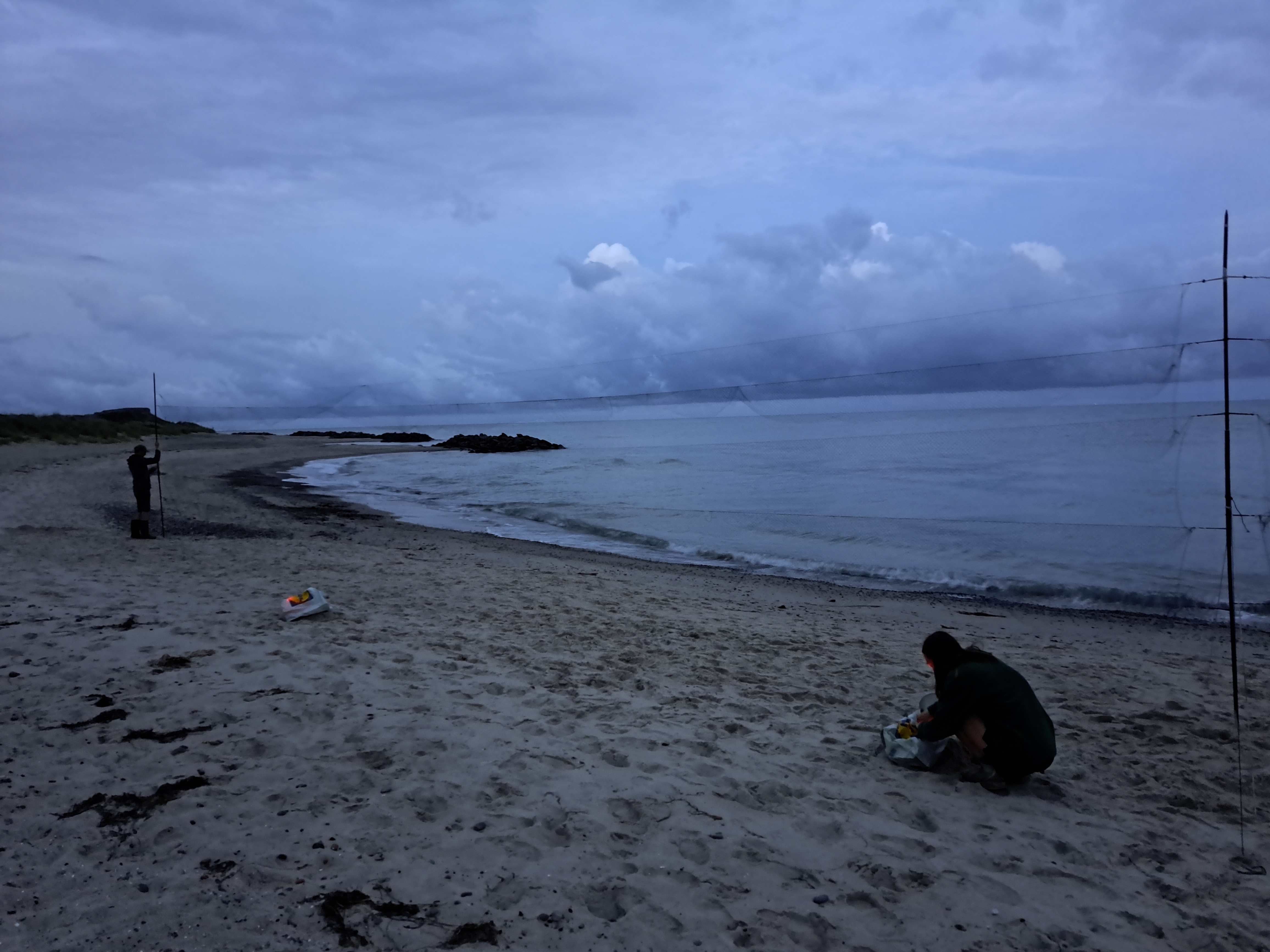 Setting up the Stormsvale net
Setting up the Stormsvale net
Luckily, there were no people on the beach when we started the Stormsvale playback. A canon of scary noises resounded over the beach, accompanied by red lights of the speaker. That is how aliens appear in movies. During the night, we kept the sky in sight- just in case. Through the scope we were able to spot Saturn and its rings. Later in the night polar lights appeared. When Sarah and I saw pictures, the others had made of the colourful sky, we first thought it would be a joke- in real life we had to look very closely to see them. Over the night they got stronger and we could see the bright lines on the sky. That was very impressive. Together with some shooting stars they created a perfect atmosphere.
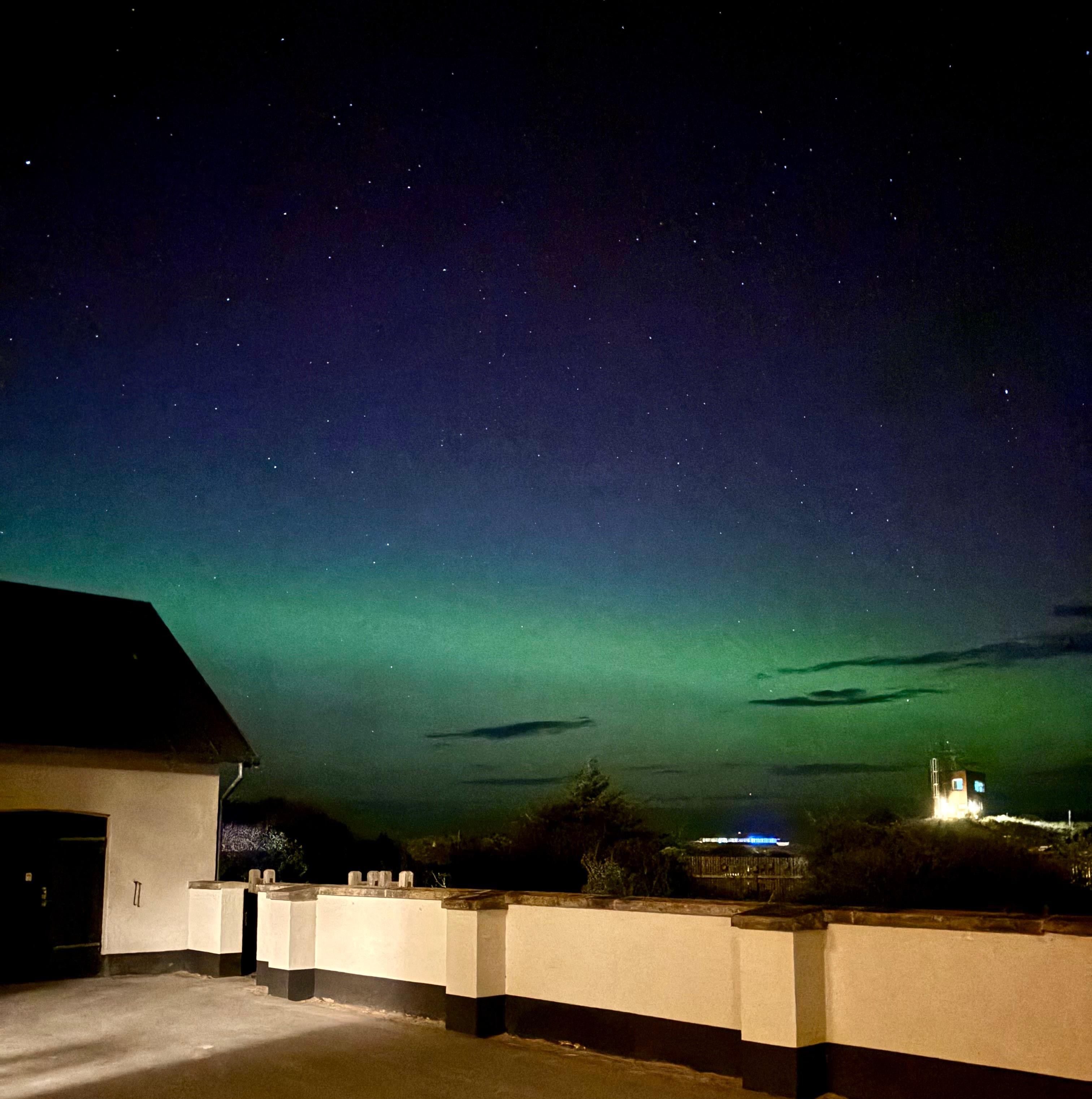 Ideal conditions to stay awake
Ideal conditions to stay awake
Regularly, we were checking the nets. Between the rounds we looked out for moths that came to the moth trap we built. There were some interesting ones and after rounds with no birds in the net it was nice to see some new moths. Our favourite one was an Ennomos (probably the Canary-Shouldered Thorn/ Elle-Tandmåler) and we accidentally brought in into the house. There it was very clingy, climbing on our fingers and trying to stay in the house. But Selina managed it to bring her new friend outside again.
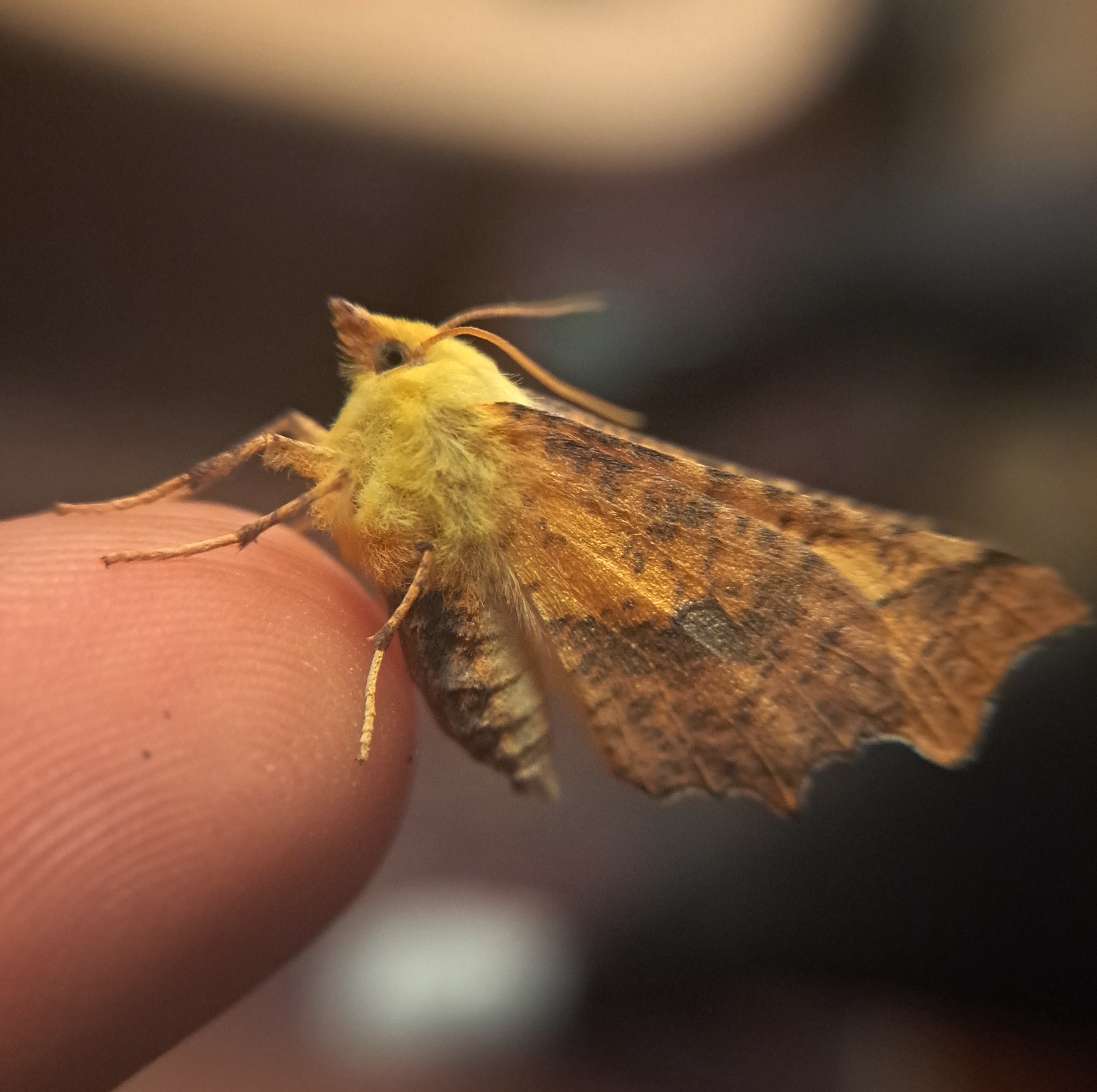 Our little friend the Thorn
Our little friend the Thorn
Because the nets stayed empty, Lille Simon and Youri went out to catch some birds with the net. They came back with a Skylark (Sanglærke). So, we had a bird to ring. When it got later, the others went to bed. Lille Simon and I stayed awake to check the nets. Driven by the believe to find a Stormsvale, I was not tired. Sadly, no bird appeared in the nets.
In the morning, we had to say goodbye to Simon (it was nice to see you again, we hope you had a nice travel back) so Sarah is the only one left from the former team. And as it is often when someone leaves, after that there was a cool bird found. They caught a Barred Warbler (Høgesanger) at Kabeltromlen. I counted in the morning with Knud from worlds end 3 and when we heard that, we headed out to see the bird. When we arrived at Kabeltromlen, the ringers were busy with many birds. Besides the Barred Warbler (Høgesanger) there had been around 15 birds in the nets this round. We were all very happy to see this beautiful bird so close. With two Barred Warblers (Høgesanger) caught, this season is pretty good for the species.
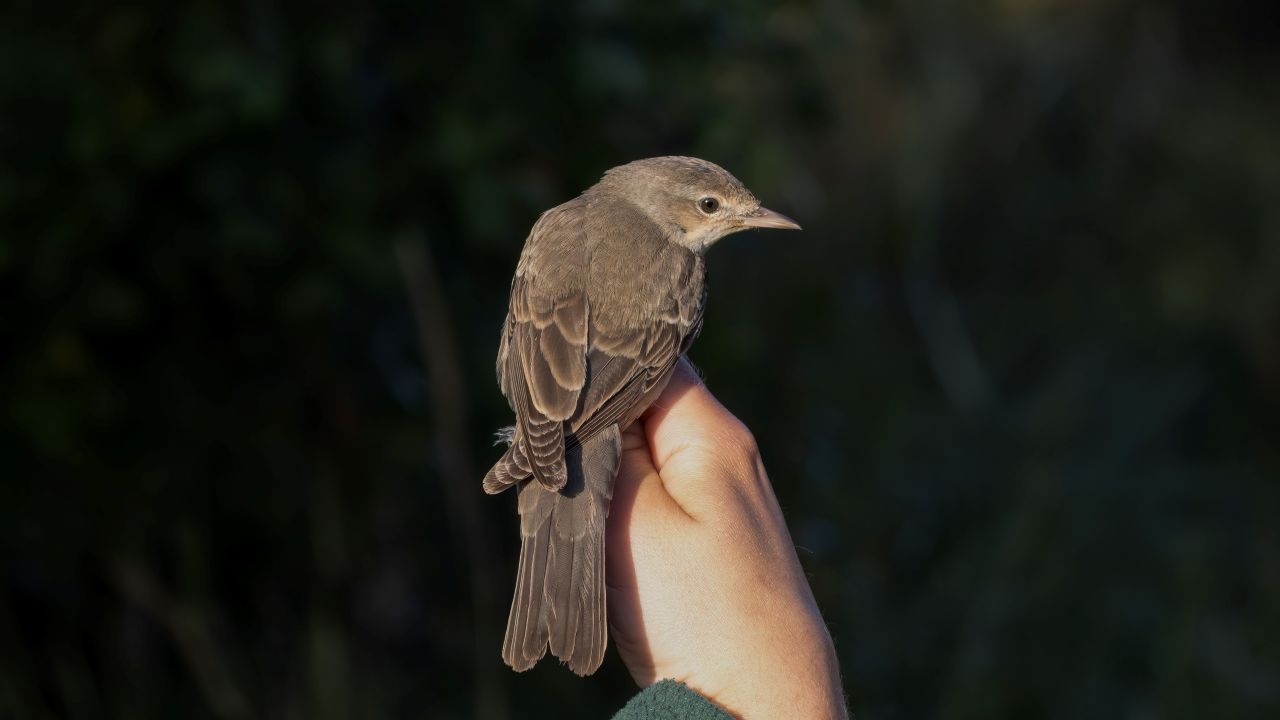 1cy. Barred Warbler (Høgesanger)
1cy. Barred Warbler (Høgesanger)
One Barred Warbler (Høgesanger) later, Knud and I arrived back at the beach. There Knud focused on the gulls and read some colour rings. The sea was very calm and there was not much migration going on. Around Kabeltromlen there were many passerines in the bushes. It was again a good day for Coal Tits (Sortmejse). 265 of them flew through the area and 12 of them got caught.
Around noon we were all back at the station. After some resting and Sarahs daily swim we entered some data. After that I went on a walk to look if some passerines had hidden in Ellekrattet. There were some birds around in the wake of the trees. In the evening we said goodbye to Youri (also have a good travel home :))
Now Selina is cooking some nice food. Let´s see what tomorrow will bring. The weather forecast looks inconvenient for ringing. But maybe there will be some more migration on the sea. Vi vil se.
Ringing (Kabeltromlen):
Høgesanger 1
Gulspurv 1
Rødhals 11
Løvsanger 1
Rørsanger 1
Sortmejse 12
Grå fluesnapper 1
Rødstjert 2
Gærdesanger 1
Tornsanger 1
Rørspurv 1
Munk 3
Lille dompap 1
Gransanger 3
Fuglekonge 1
Jernspurv 1
Total 42
Highlights from World’s End 3:
Rørhøg
Krikand
Islandsk ryle
Kaspisk måge 7
Gråstrubet Lappedykker
Today’s observations in Dofbasen from observers in the area.
People:
Selina Veng, Janna Ouedraogo, Sarah Partridge, Simon S. Christiansen, Youri Van der Horst, Simon Kiesé, Knud Pedersen, and our guests Helle and Johan.
Lille Sheriff's goodbye Tit Party
Last night the four of started our group bonding by going out hand catching at the beach. We went to Grenen on the sandworm track and walked around for a while, but all we saw were three Red Knots (Islandsk Ryle) who flew away before we even got close. After a little bit we gave up and stopped by the kiosk to catch a few House Martins (Bysvale) and house Sparrows (Gråspurv), which we brought back to the lab and Selina ringed her first bird! We then delivered the Bysvale back to the kiosk and called it a night.
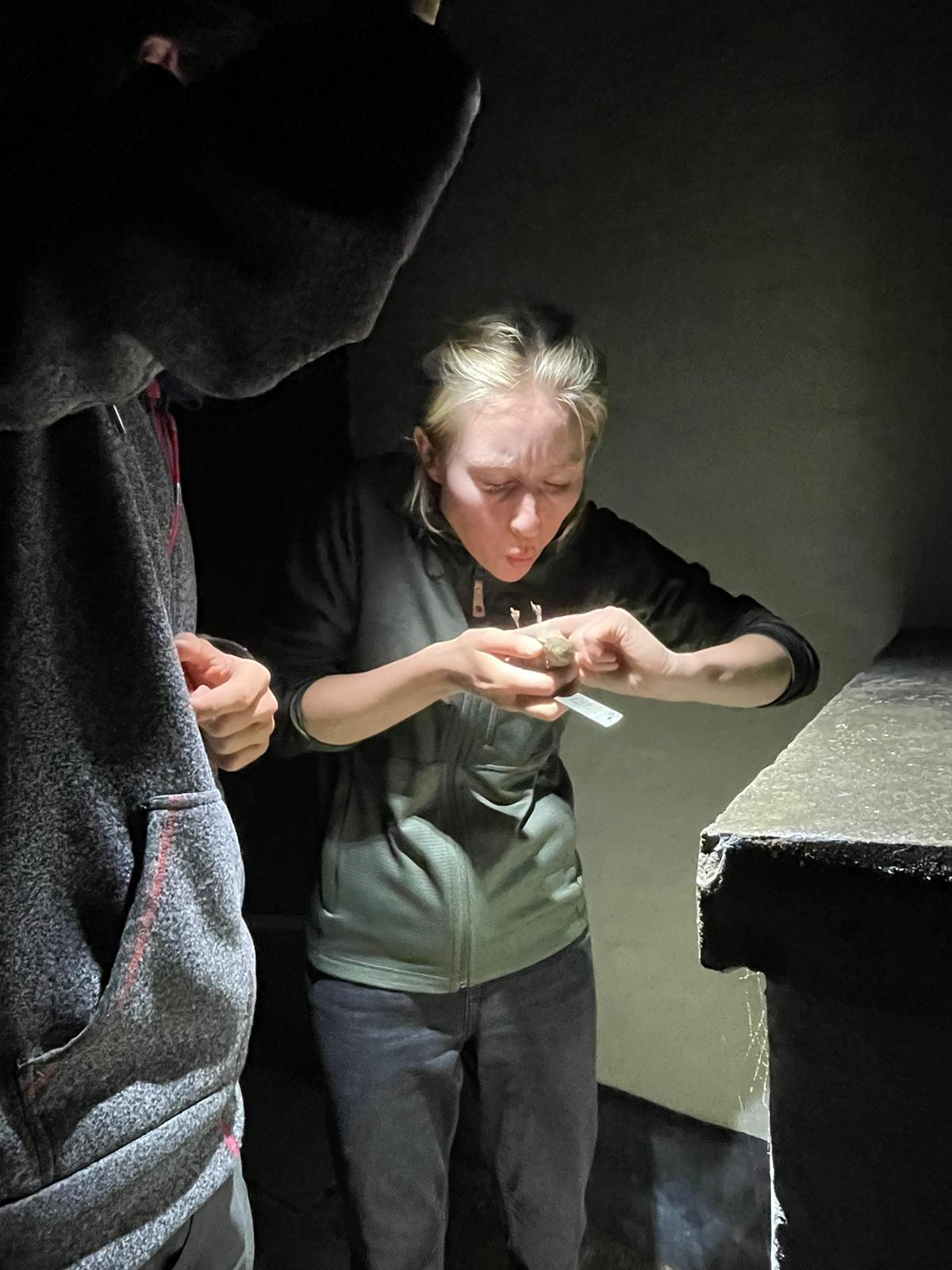
This morning I went with Selina to open the nets at Kabeltromlen and show her the route where all the nets are. We were joined by Lille Simon, who seems to have finally caught up on sleep just in time for a night of storm petrel catching, and Youri and SSC also joined us. We had a very good day with three different types of tits (Musvit, Sortmejse, and Blåmejse), a few Robins (Rødhals), one adult female blackbird (solsort) looking quite scrappy in wing and tail moult, and a very fine adult Gærdesanger specimen. We also had over 100 sortmejse flying overhead as well as a Havørn (White-tailed Eagle) which passed by very close several times.
Janna went out observing with Knud, where they had a still morning over the sea. Highlights included Lille flagspætte (Lesser spotted woodpecker), Rørhøg (Marsh harrier), Sølvhejre (great egret), and 6 Kaspisk måge (Caspian gulls). Janna even found time to age the resting Sule while Knud read some gull rings.
After lunch together and a swim with Janna, I went to the shop for provisions and Selina went to explore Skagen town while the others went out birdwatching. Lille Simon went to the beach for is final seawatch, and although he wasn’t able to get the nice gull photos he wanted, he was happy to see a carrion crow (Sortkrage) on the beach.
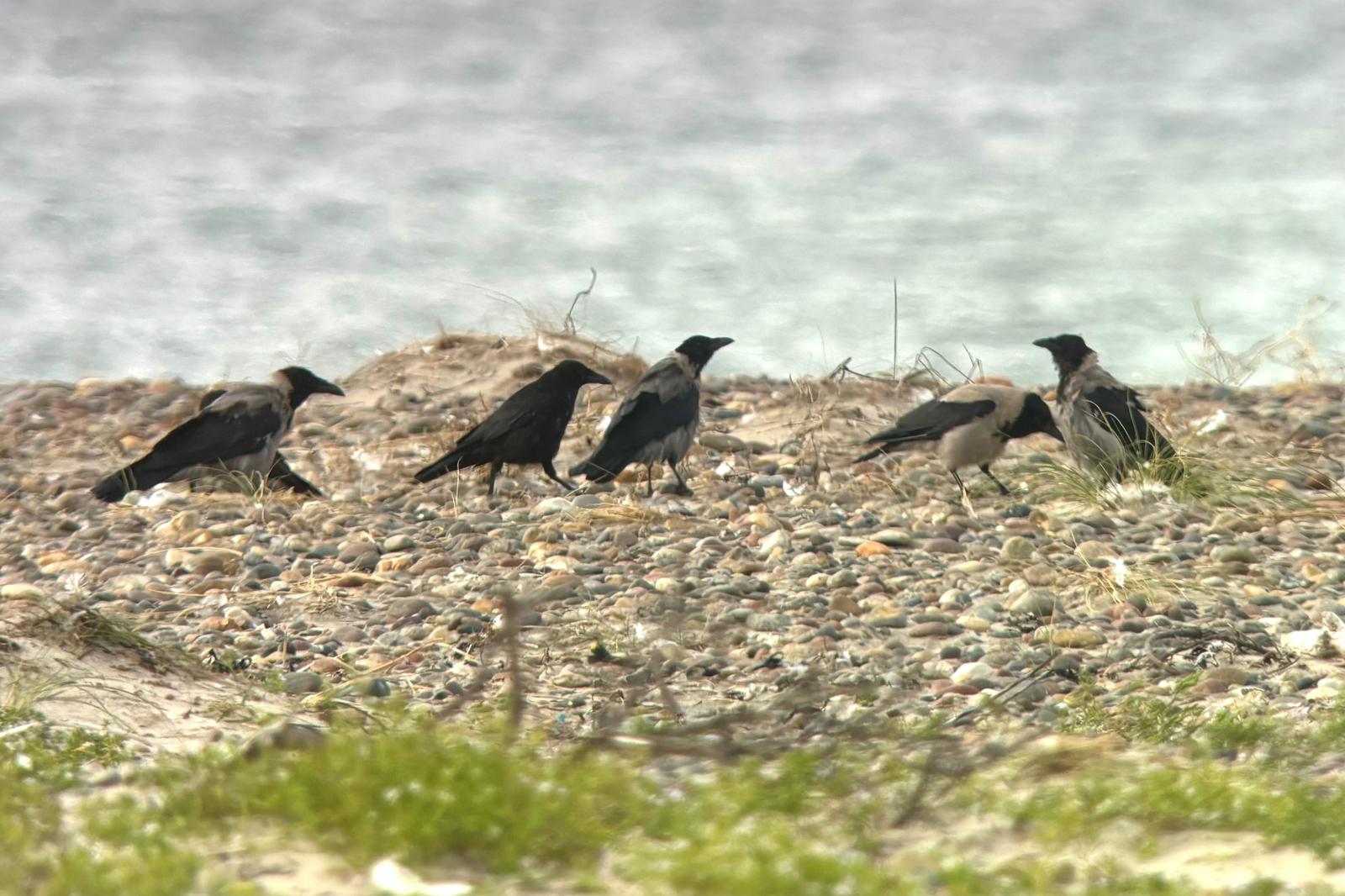
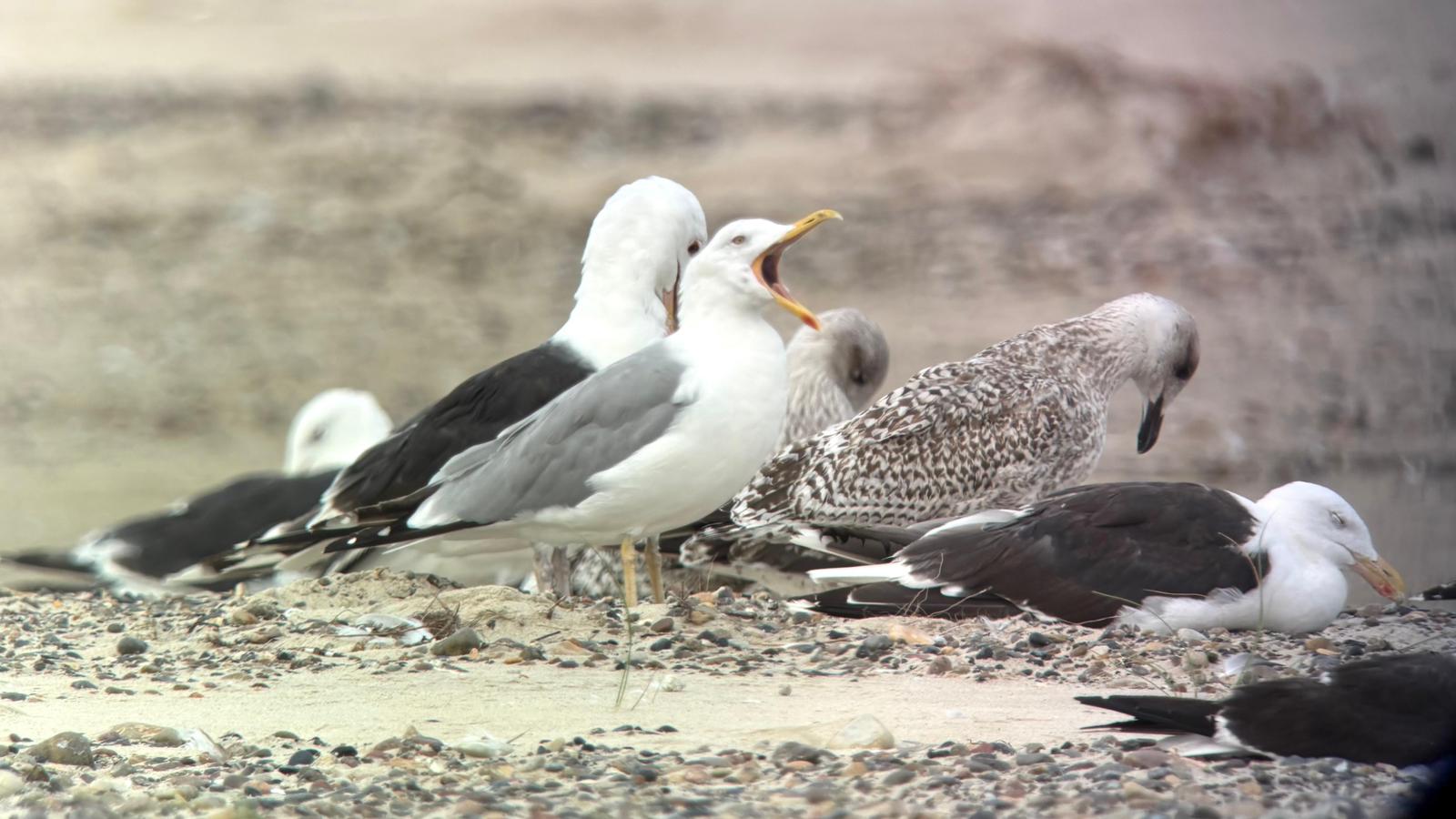
Janna went out along the boardwalks and had a nice time looking at dragonflies, adders, frogs, wheatears (stenpikker), and many passerines flying around.
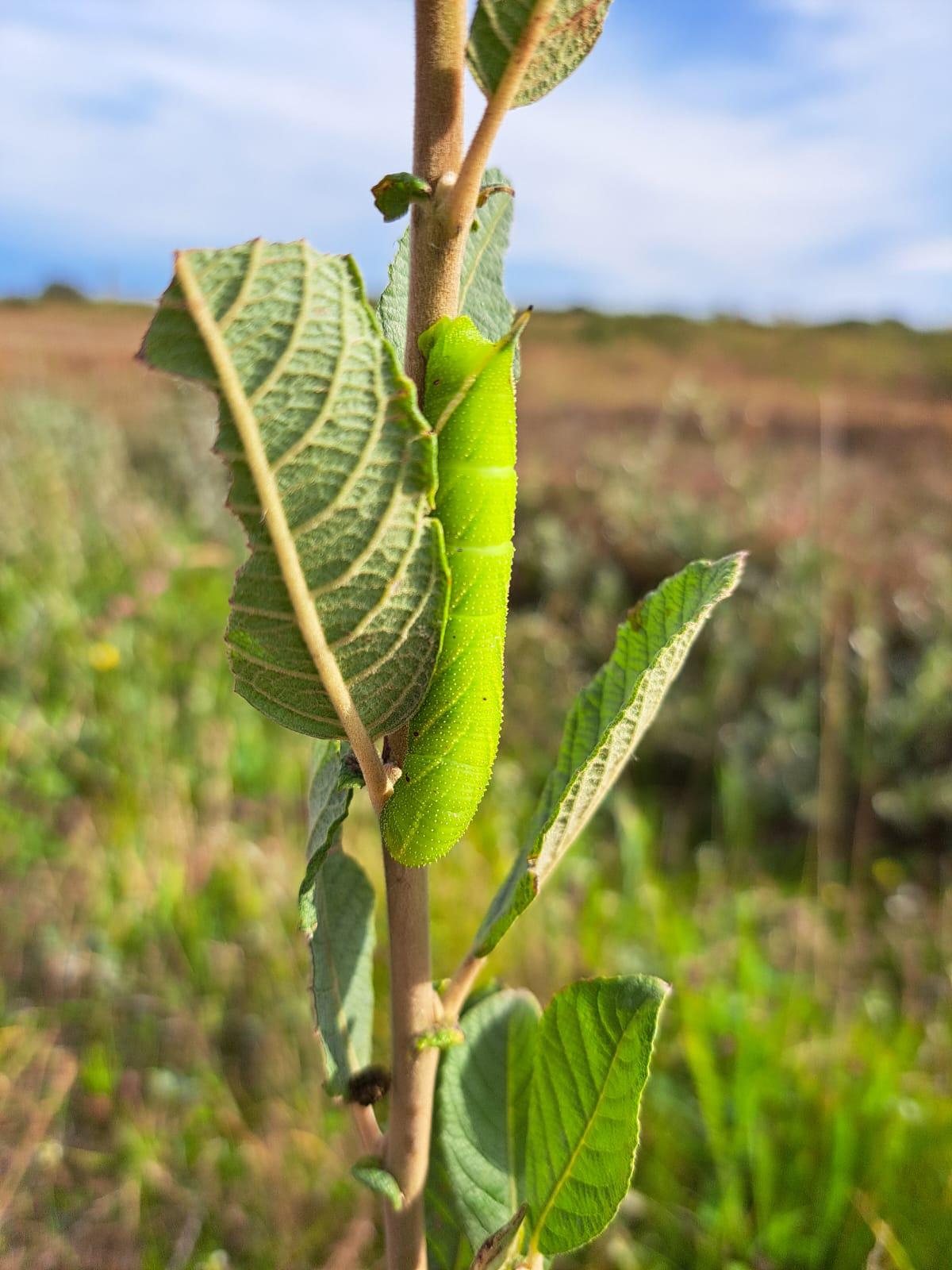
Then we joined together again for a delicious dinner cooked by Janna, followed by crumble she made with some apples donated from the garden of our guests Helle and Johan. Now we will set out the storm petrel (stormsvale) and nightjar (natravn) nets so Lille Simon can forfeit his last night of sleep to see what we can catch. Janna and I put out a makeshift moth trap (which has nothing on Hanelie’s) so we will check this for a few hours to see if any moths can be tempted.
Ringing (Kabeltromlen):
Solsort 1
Musvit 1
Rørsanger 3
Rødhals 3
Jernspurv 3
Løvsanger 1
Gærdesanger 1
Sortmejse 5
Tornsanger 6
Munk 4
Blåmejse 1
Gransanger 4
Bogfinke 1
Total 34
Highlights from World’s End 3:
Lille flagspætte
Rørhøg
Krikand
Islandsk ryle
Kaspisk måge
Today’s observations in Dofbasen from observers in the area.
People:
Selina Veng, Janna Ouedraogo, Sarah Partridge, Simon S. Christiansen, Youri Van der Horst, Simon Kiesé, Knud Pedersen, and our guests Helle and Johan.
Sheriff Simon and his Snipes
The Milky Way hung hidden by dark clouds over the Støvring plains. Somewhere out there, under the cloak of darkness, the birds were sleeping. But not us. Not tonight.
Simon Jr. - better known in these parts as the Lille Sheriff - tightened his boots, adjusted his headlamp, and gave a nod to his seasoned partner, SSC (Simon Sr.), the old gunslinger of bird science. Armed with torches and trusty handnets that swung like lassos in the night, we rode out to two secret spots near Støvring. The mission? To track, catch, and ring the elusive Great Snipe (Tredækker). And let me tell you, pardner - it wasn’t our first rodeo.
With the stealth of bity cats and the precision of diving gannets, we managed to lasso one Skylark from the shadows. A fine catch. But just as we were admiring our feathered prize, Johan Funder rolled in like a whirlwind from the north. While we were wrangling one, he was rounding up five: three Common Snipes (Dobbeltbekassin) and two Skylarks (Sanglærke). The man’s got bird sense like Indiana Jones got whip skills.
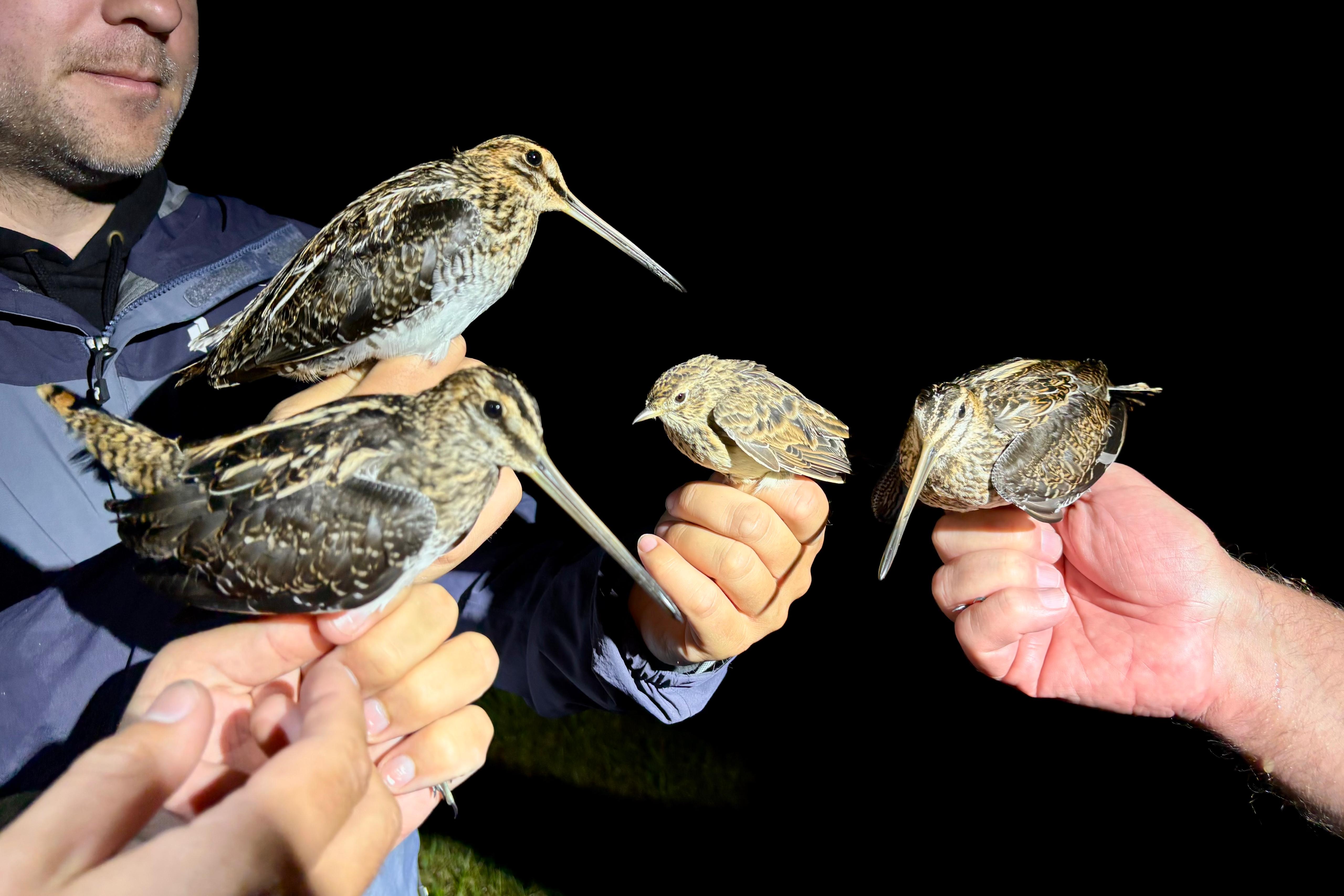 Three Common Snipes (Dobbeltbekassin) and a Skylark (Sanglærke).
Three Common Snipes (Dobbeltbekassin) and a Skylark (Sanglærke).
Not long after, Lars Bo appeared on the horizon, boots crunching through the dewy grass. The posse was complete.
We saddled up and headed to the second site, where the night’s true treasure awaited: an adult Great Snipe (Tredækker). A rare gem in the ornithological wild west. I had the honor of measuring it myself - its plumage glowed like ancient gold under the torchlight. A moment of awe, etched into memory.
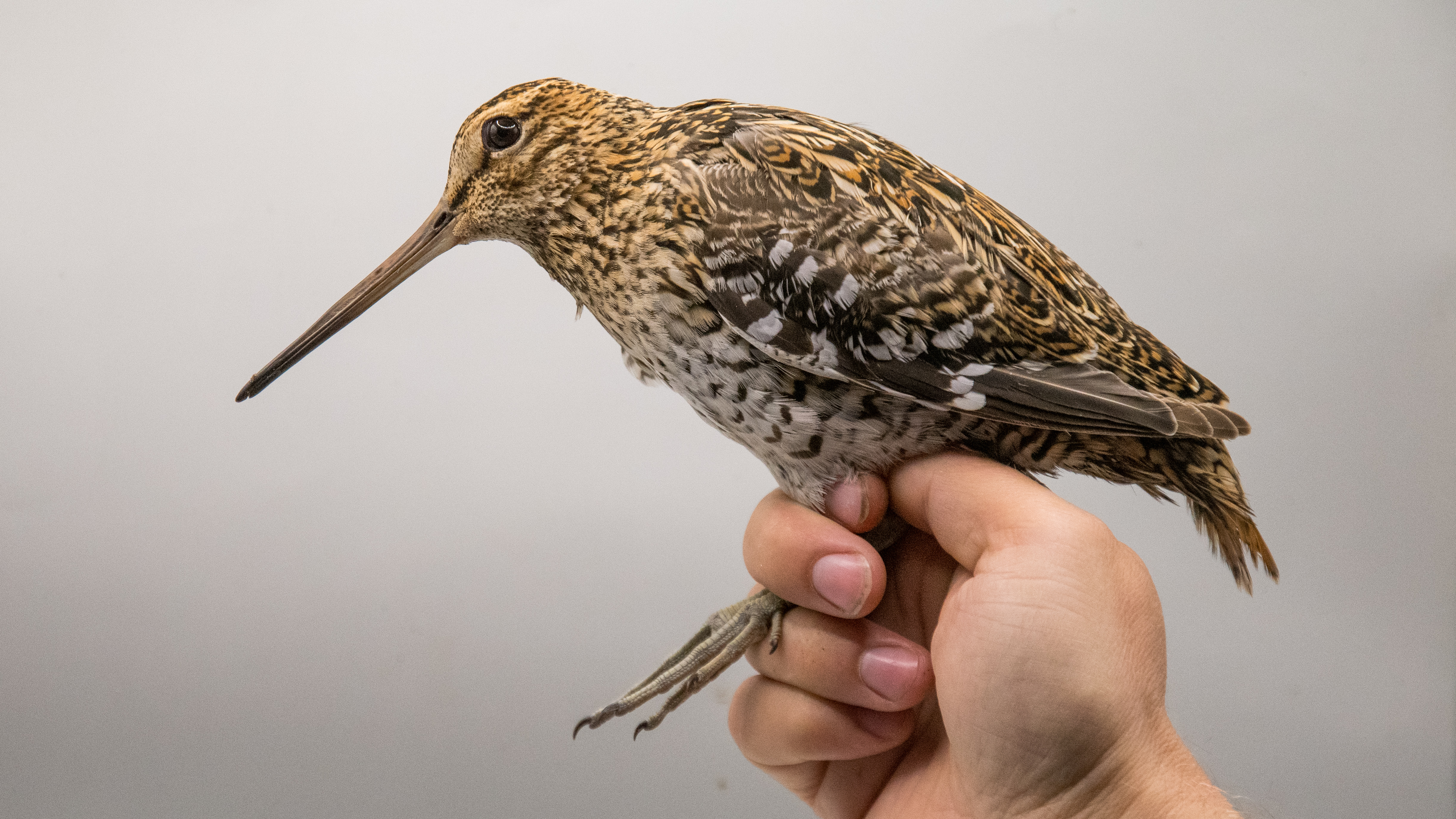 Look at this beauty: Great Snipe (Tredækker)!!!
Look at this beauty: Great Snipe (Tredækker)!!!
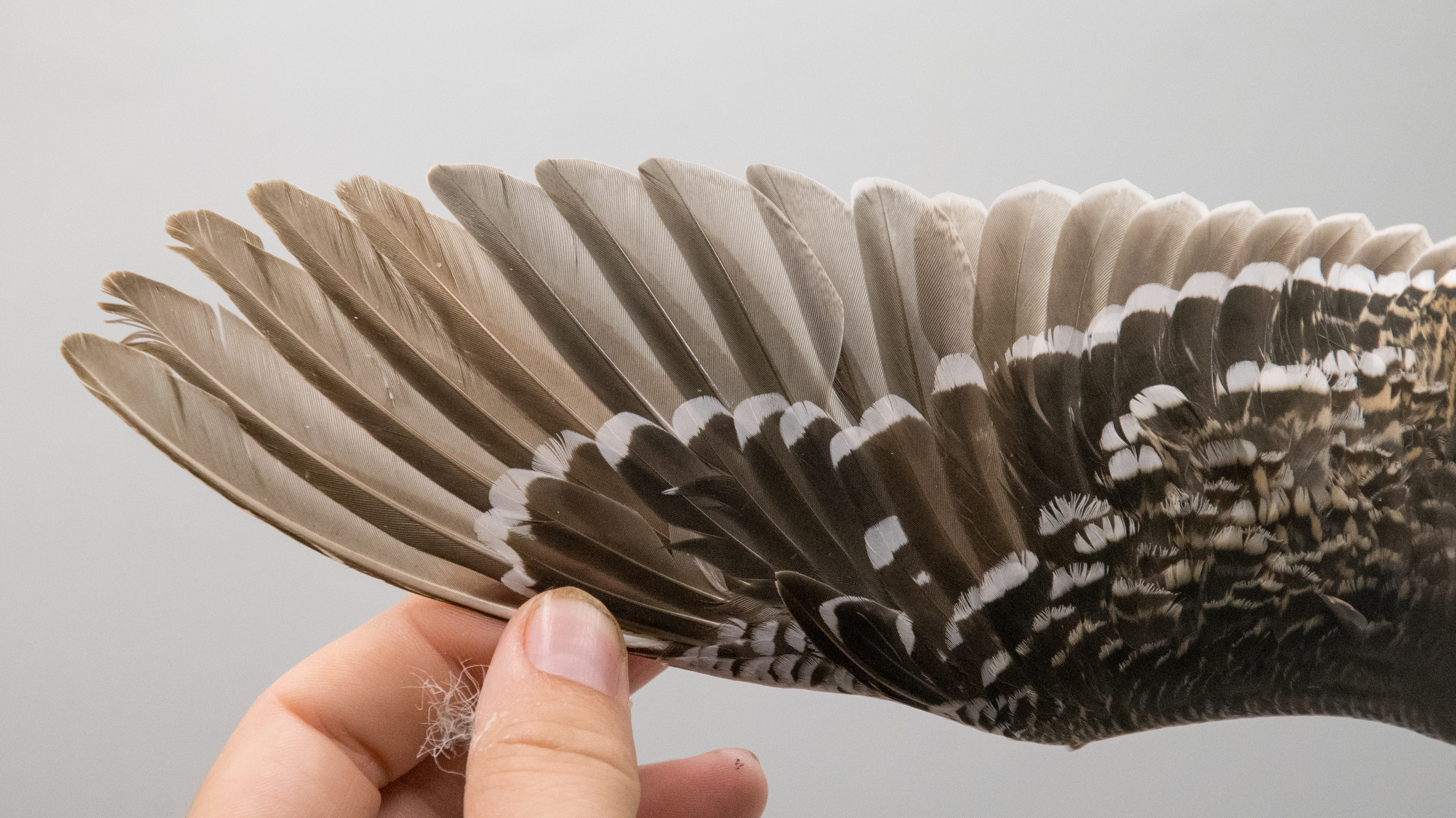 Two feather generations in the wing: this bird interrupted its moult. The older feathers are more bleached out and brown.
Two feather generations in the wing: this bird interrupted its moult. The older feathers are more bleached out and brown.
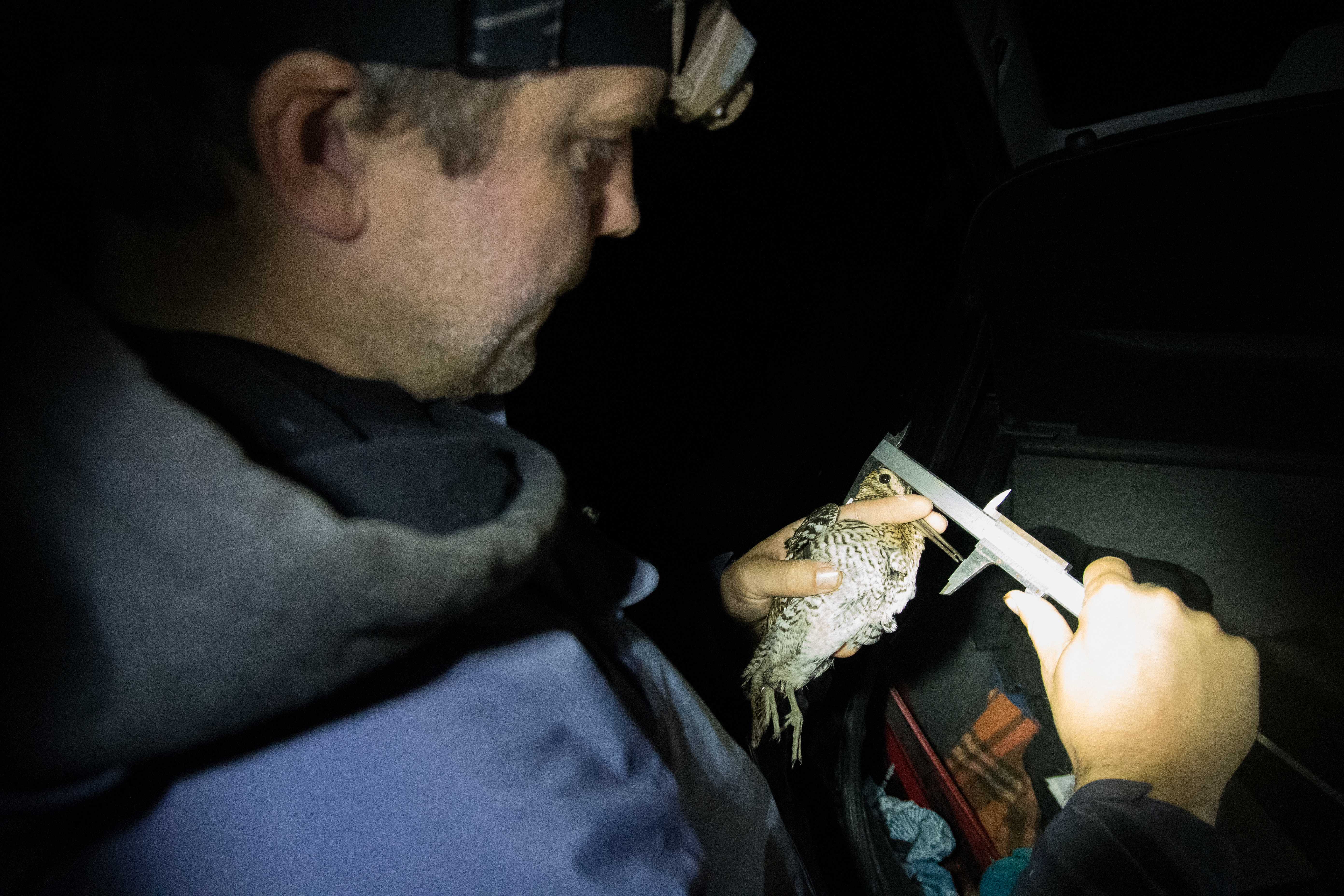 Simon Sr. measuring "Bill-Head". This measurement is very helpful in many waders.
Simon Sr. measuring "Bill-Head". This measurement is very helpful in many waders.
The ride back with SSC was quiet but rich, those kinds of talks that only happen after a night in the field. I grabbed a quick hour of sleep before heading to Kabeltromlen, where Louise and Youri had already opened the nets. The wind howled across the site, and Sarah rode her out to Denmark’s last dune to count seabirds against the crashing waves.
Ringing was slow and birds seemed to be sleeping in. But one Redwing (Vindrossel) turned up in the net, a recapture from July. Maybe an oversummering bird in the Grenen bog. A little mystery tucked into a feathered frame. And watching Louise work, I couldn’t help but smile: she’s learned so much in just one month of scientific bird ringing. Sharp hands, sharp eyes. The makings of a fine field biologist.
Between net rounds, I’d glance out over the sea, past the heads of the counters, scanning the horizon like a sheriff watching for trouble. And then it came—the best bird of the day: a Long-tailed Skua (Lille Kjove), what a surprise! The phone cell made a loud noise and I grabbed the hearer. It was Sarah, shouting excited words through the breeze: there is a Peregrine Falcon (Vandrefalk) flying over you. When we turned around we could get a quick view on it before it appeared on the horizon. Great one. Otherwise migration count was fun with many Gannets (Sule) and some pretty Velvet Scoters (Fløjlsand).
In the noon, we had to say one more painful goodbye to Louise, who headed back home today. Before leaving she offered me a meal in The Skagen Fuglestation Saloon, look at this burger!
 Homemade Veggi Burger
Homemade Veggi Burger
Even though her time at the bird observatory stopped for now, bird migration continued. I just stood in front of Det Grå Fyr to look at birds flying by, when suddenly an Arctic Skua (Almindelig Kjove) appeared. Since the Gulls (Måge) were closer, I decided to take some pictures.
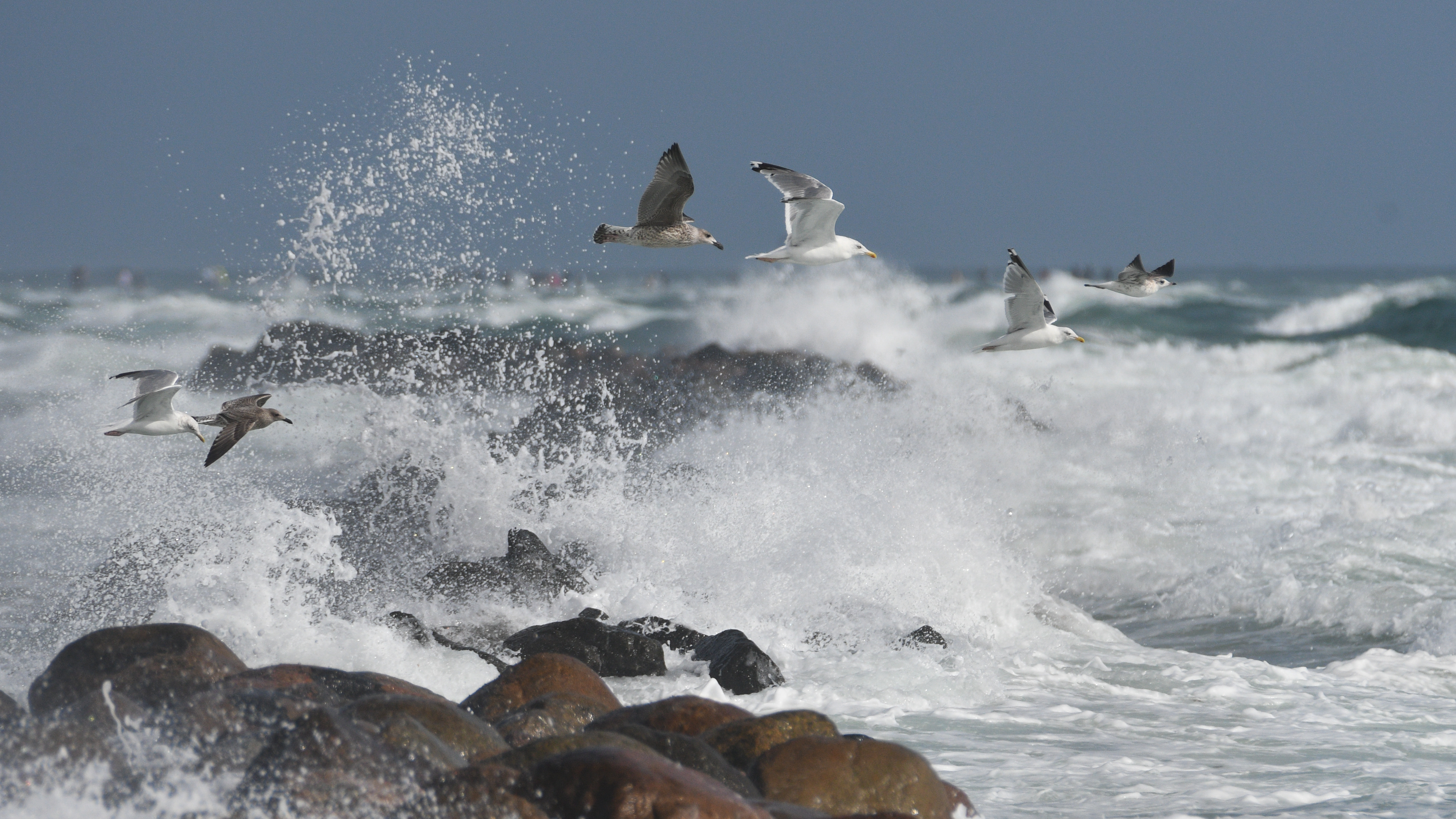 Herring Gulls (Sølvmåge) joined by a Common Gull (Stormmåge) on the right.
Herring Gulls (Sølvmåge) joined by a Common Gull (Stormmåge) on the right.
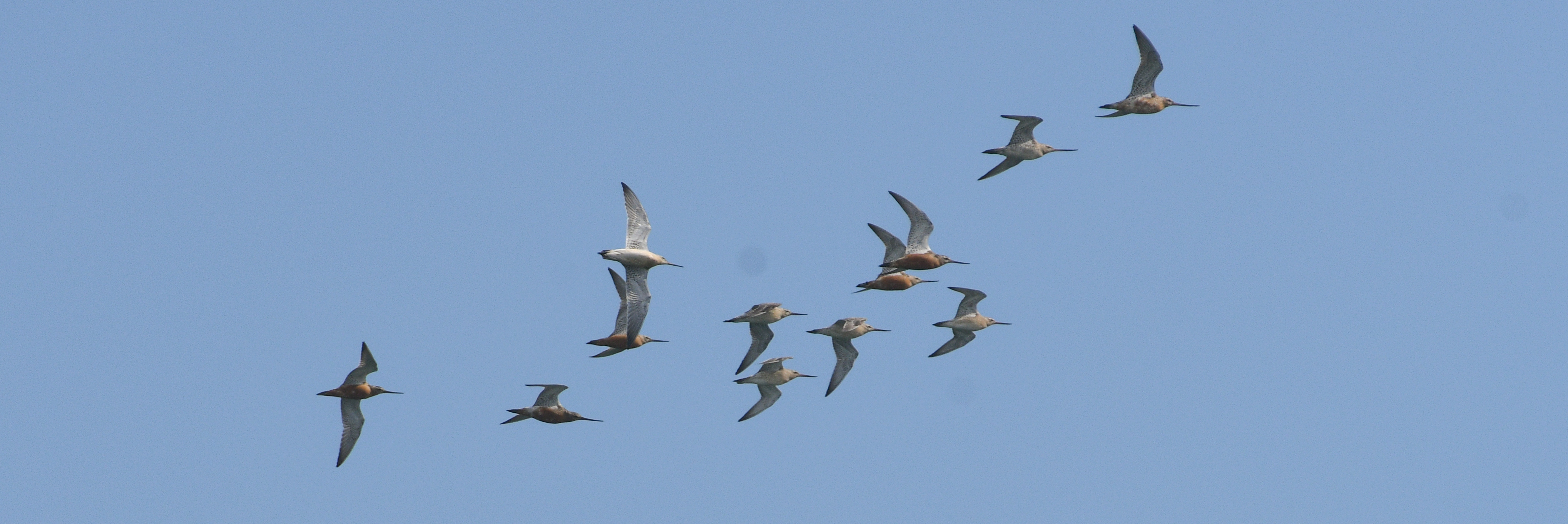 A flock of 12 Bar-tailed Godwits (Lille Kobbersneppe) passing by the lighthouse.
A flock of 12 Bar-tailed Godwits (Lille Kobbersneppe) passing by the lighthouse.
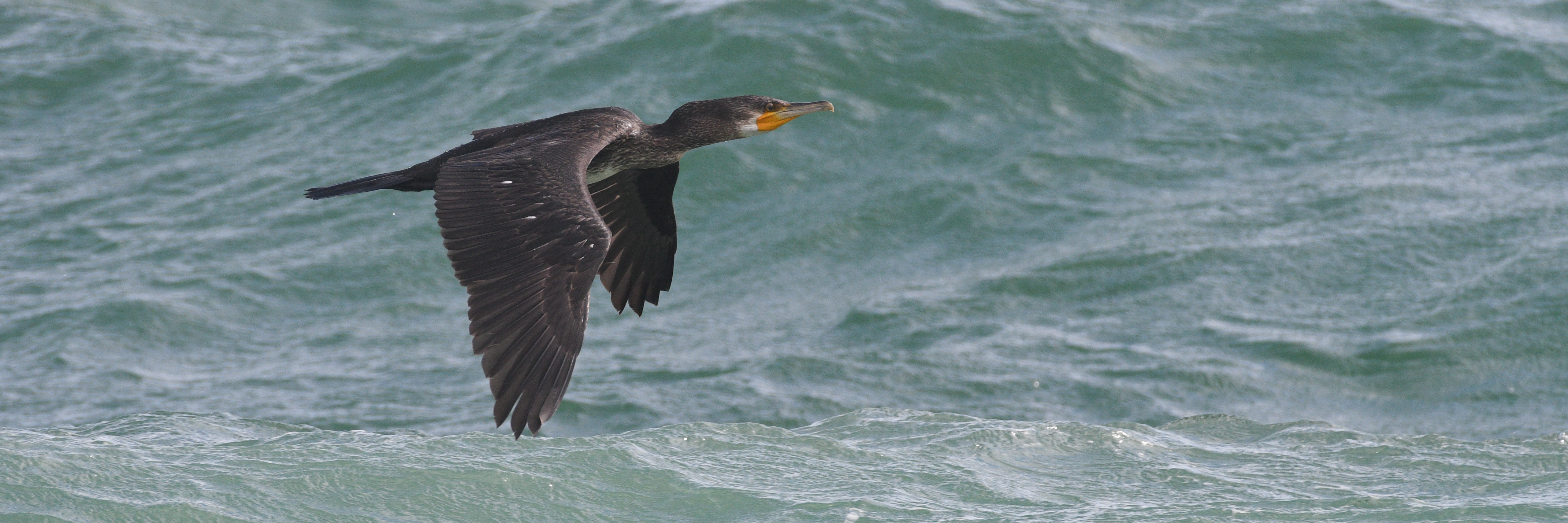 Cormorant (Skarv) does not mind the wind.
Cormorant (Skarv) does not mind the wind.
In the afternoon, Sarah and I – the last people remaining in this ghost town – climbed the lighthouse and had a nice chat with cake and coffee – ehm whiskey – in the shop. Then Selina and Janna arrived. It is nice to see both familiar and new faces at the station!
The august was really fun. Ringing was great with +156% birds caught in comparison to my August 2023. Soon I will have to mount my horse and gallop back to Germany into the sunset. Thanks to all the nice people at the station!
Why did the Lille Sheriff wear two hats? One for the sun, and one for the attitude.
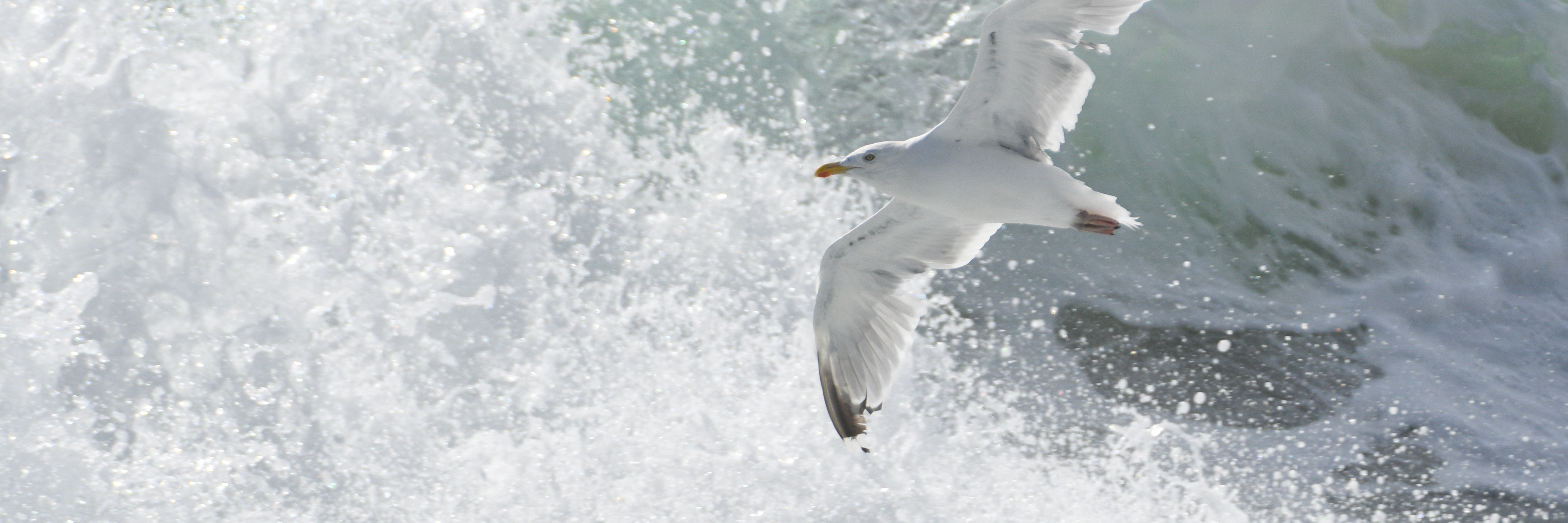
Spotted Flycatcher (Grå Fluesnapper) 1
Blackcap (Munk) 2
Ringing (Lindenborg):
Skylark (Sanglærke) 3
Common Snipe (Dobbeltbekassin) 3
Ringing (Volsted Kær):
Great Snipe (Tredækker) 1
Skylark (Sanglærke) 4
Meadow Pipit (Engpiber) 1
People: Selina Veng, Janna Ouedraogo, Louise Buksti-Ladefoged, Sarah Partridge, Simon S. Christiansen, Youri Van der Horst, Simon Kiesé, Johan Funder, Lars Bo Jakobsen and our guests Helle and Johan.
